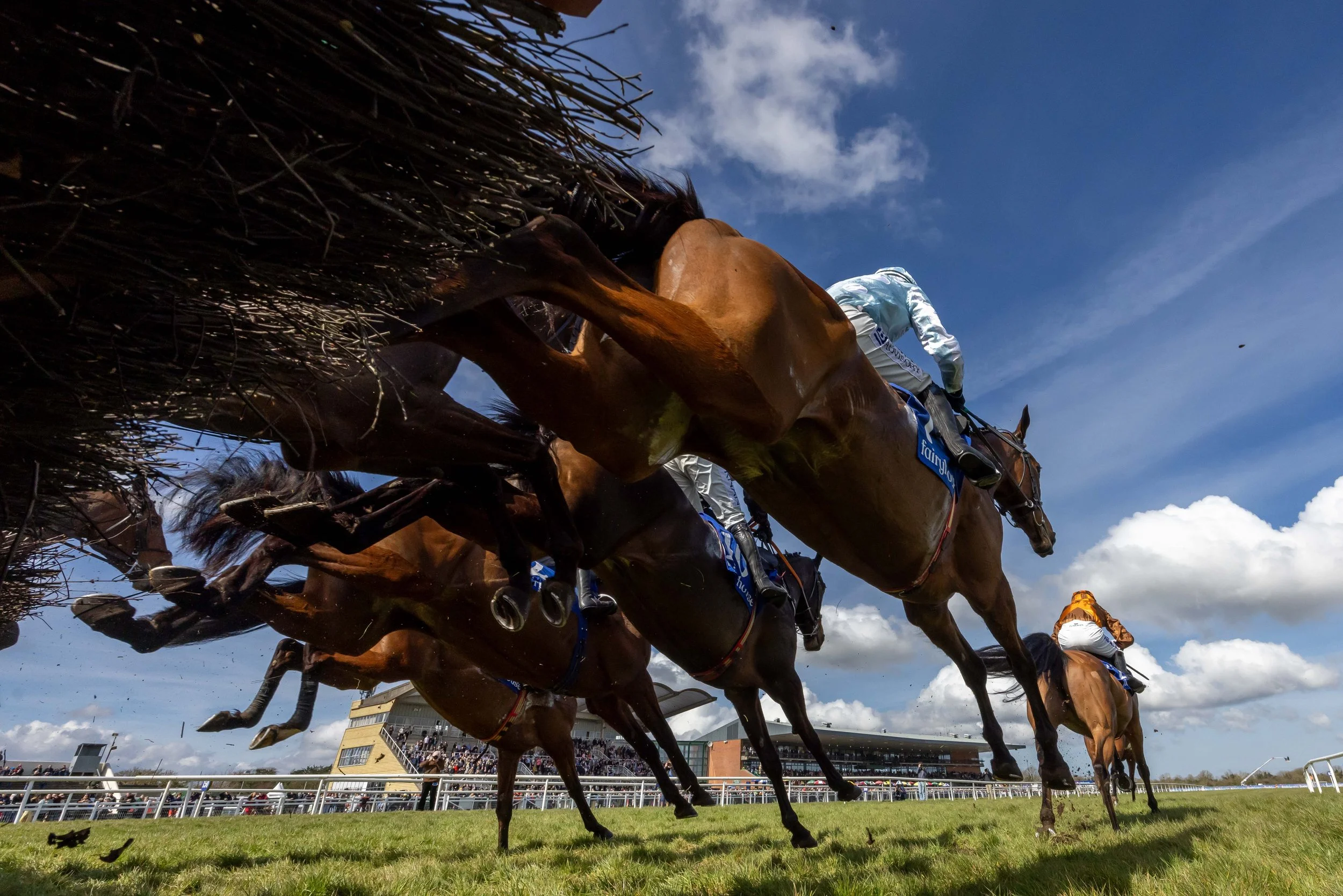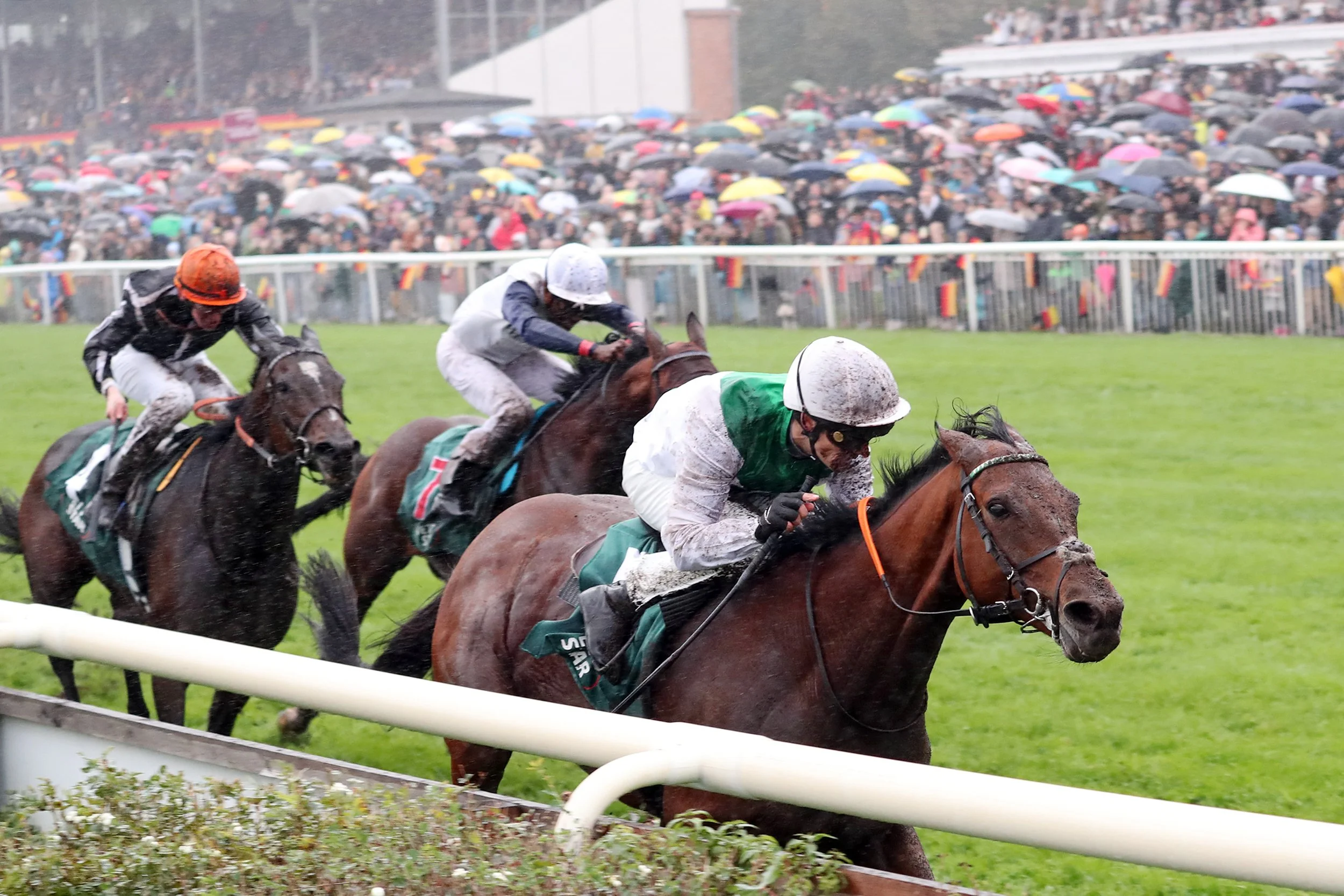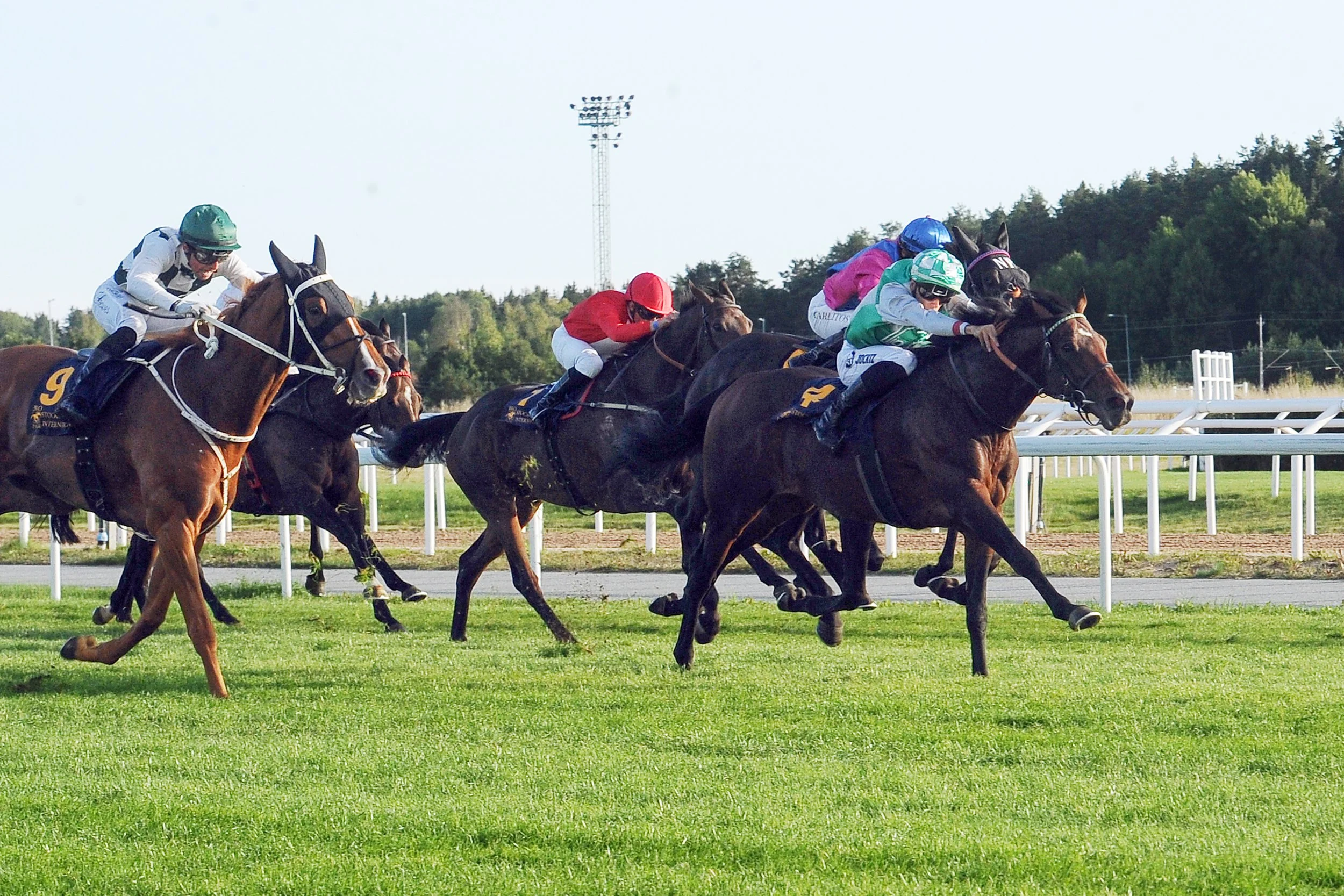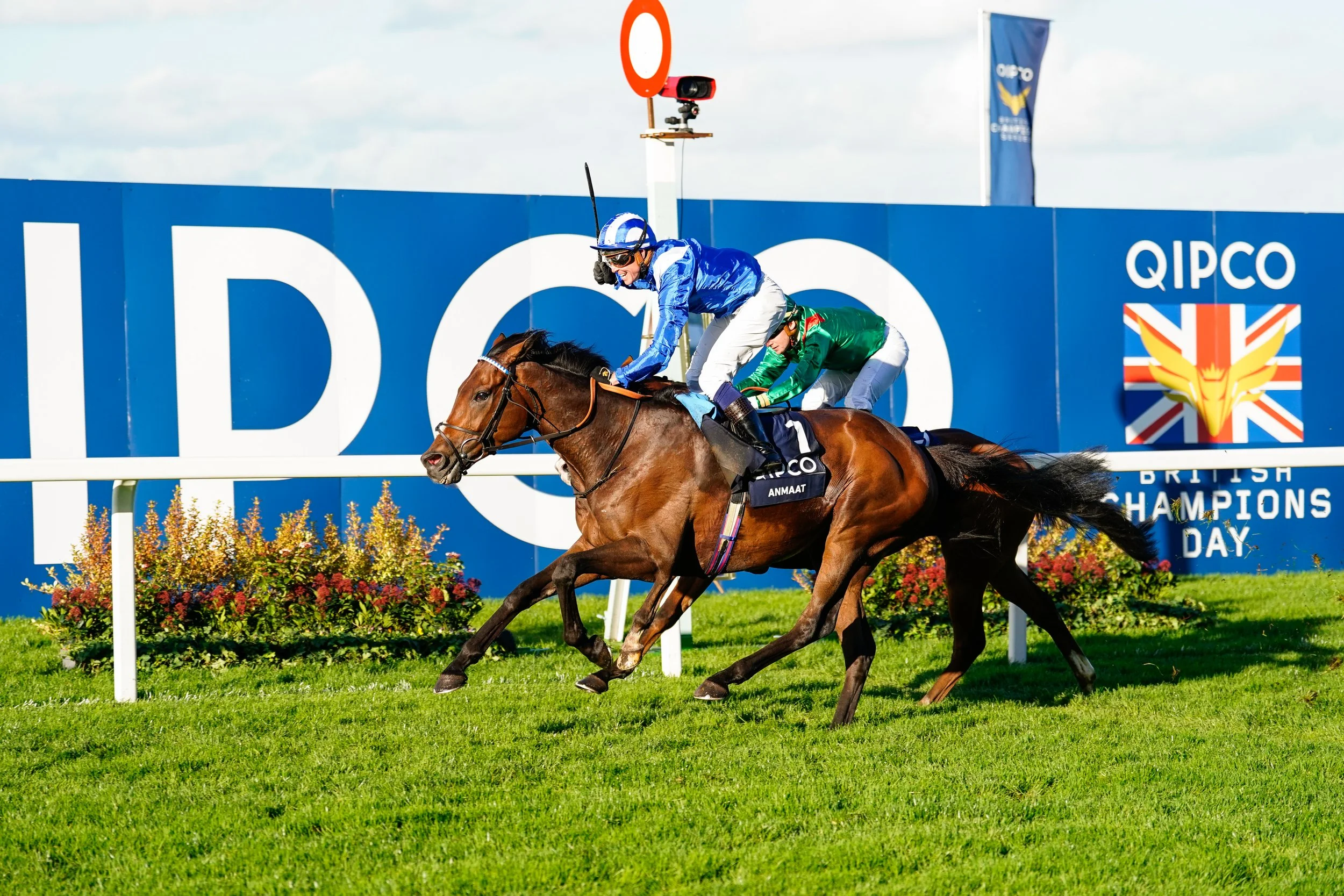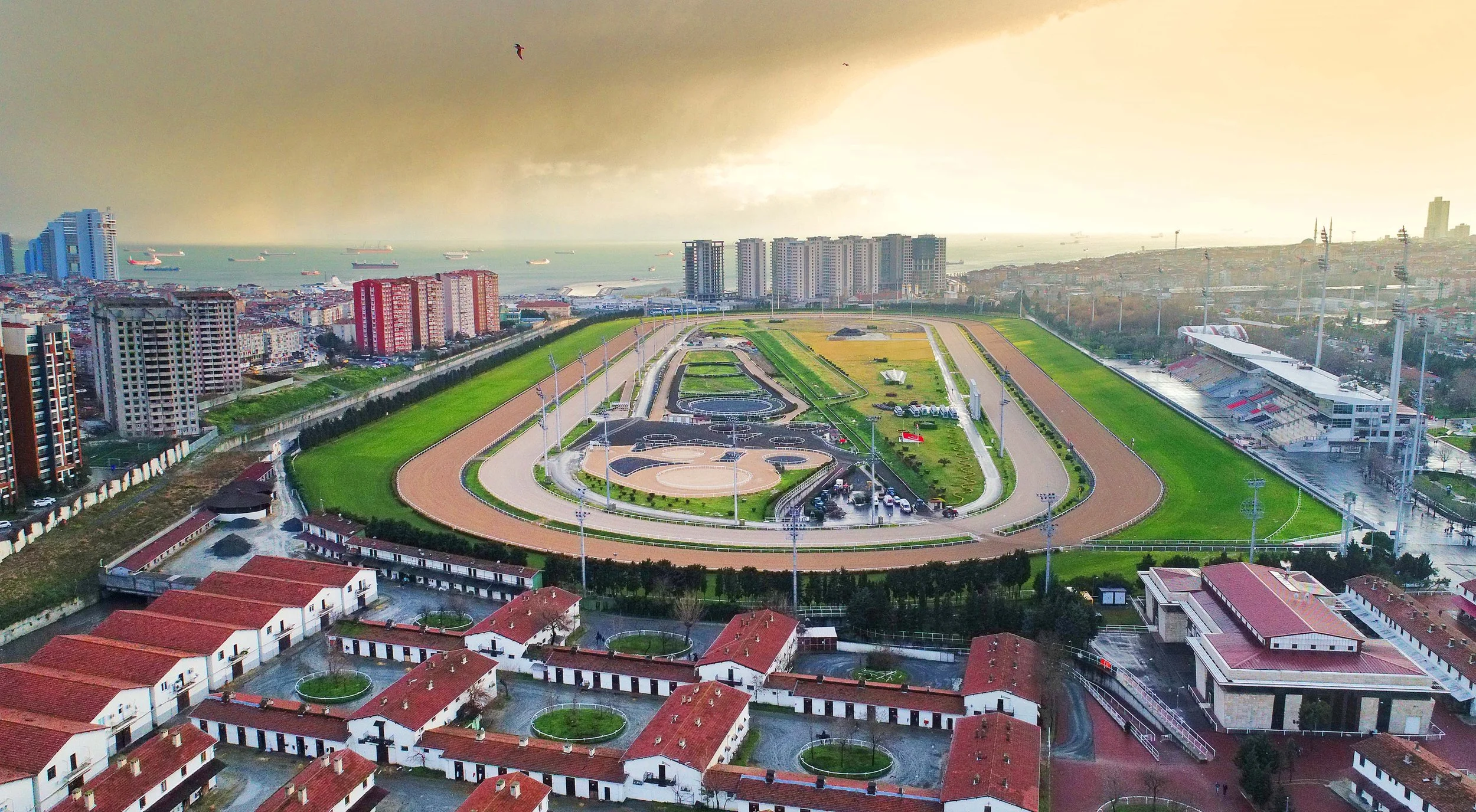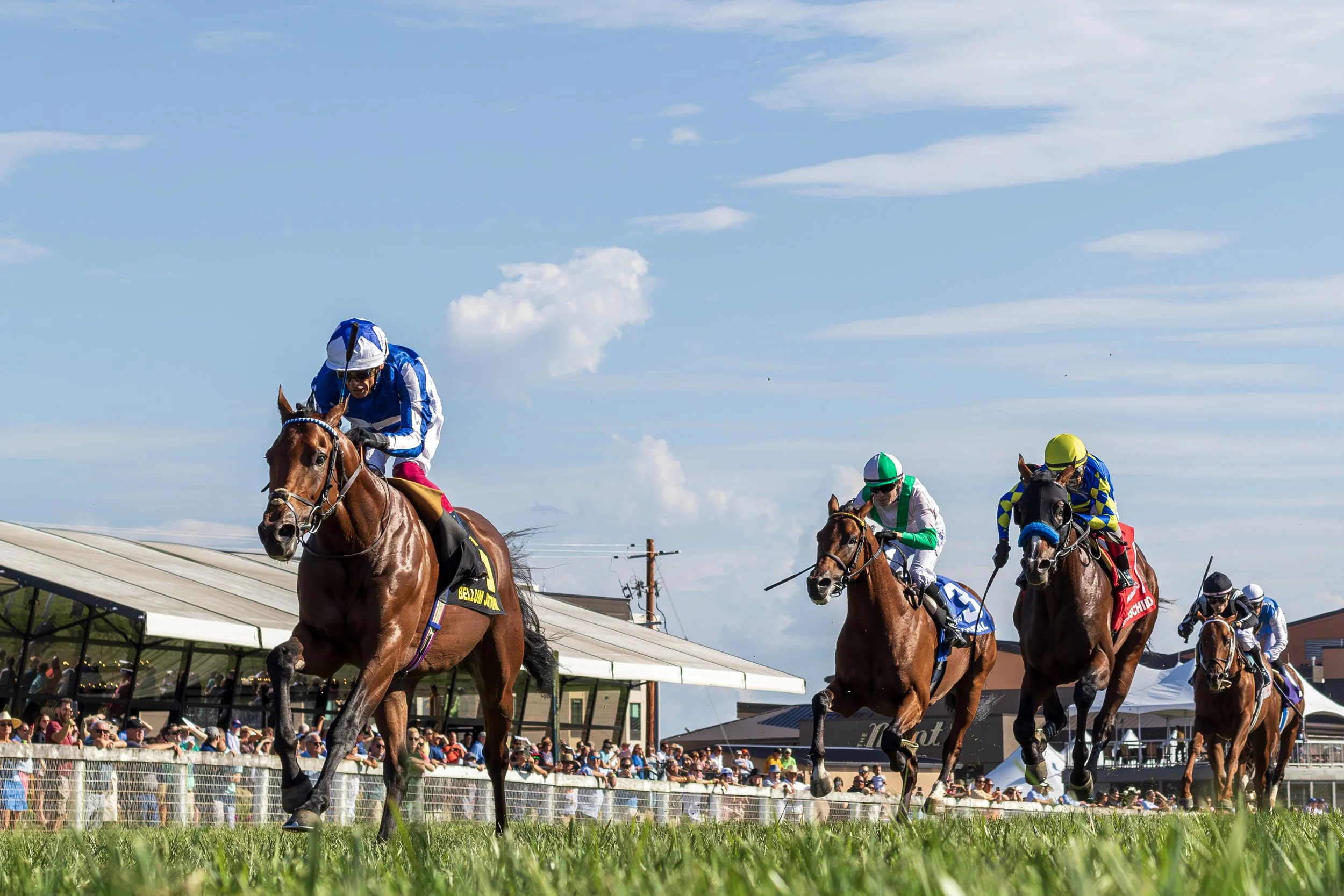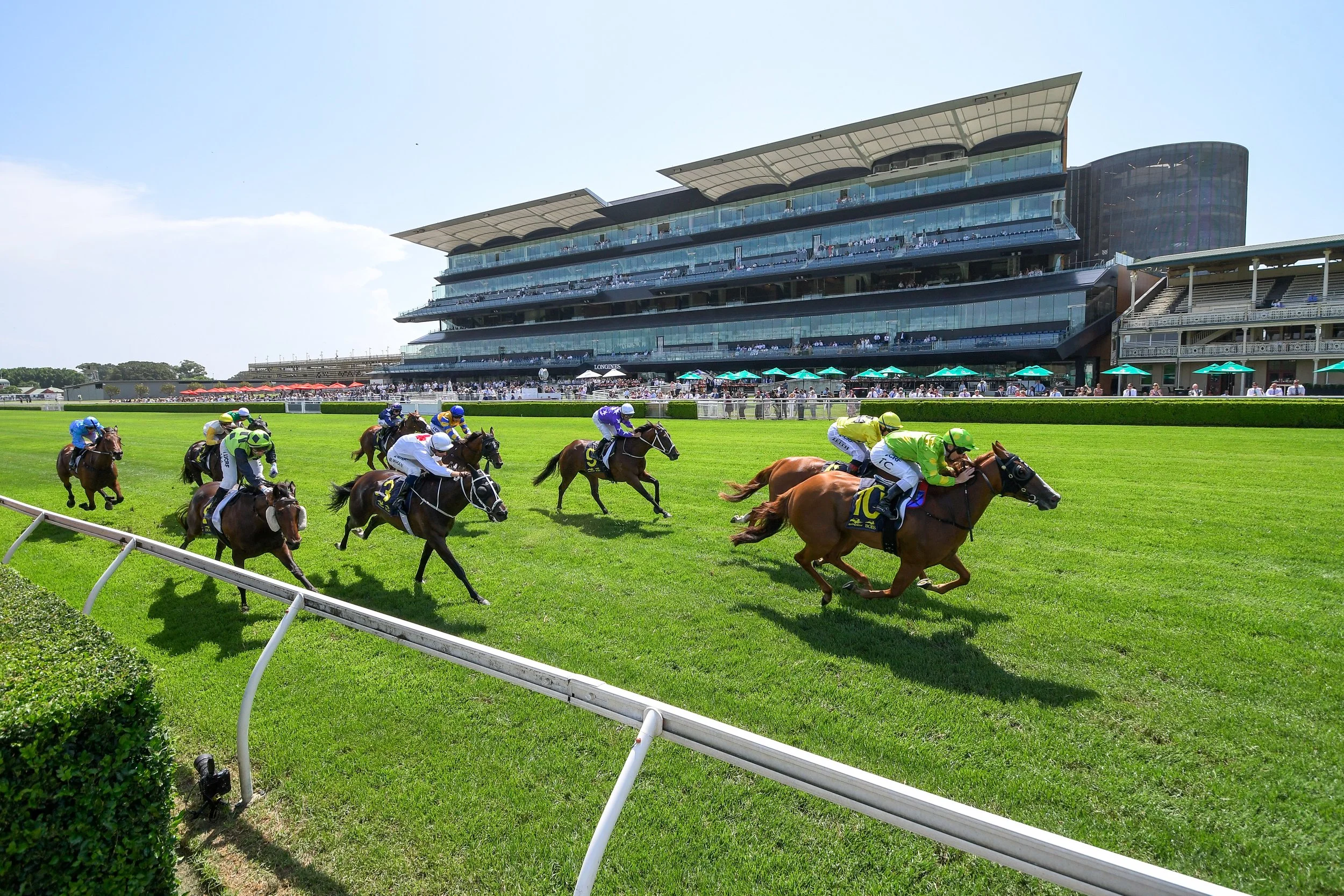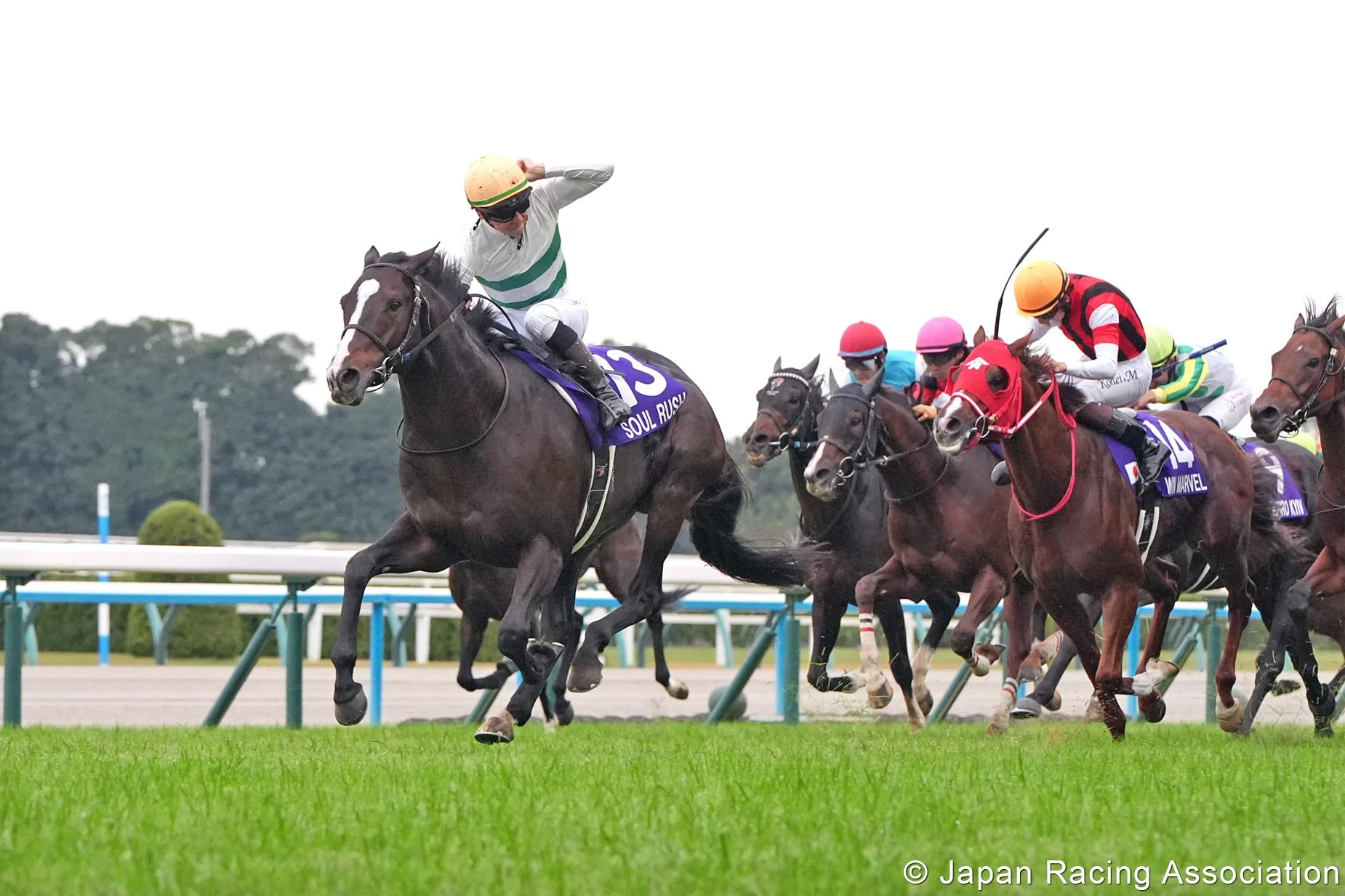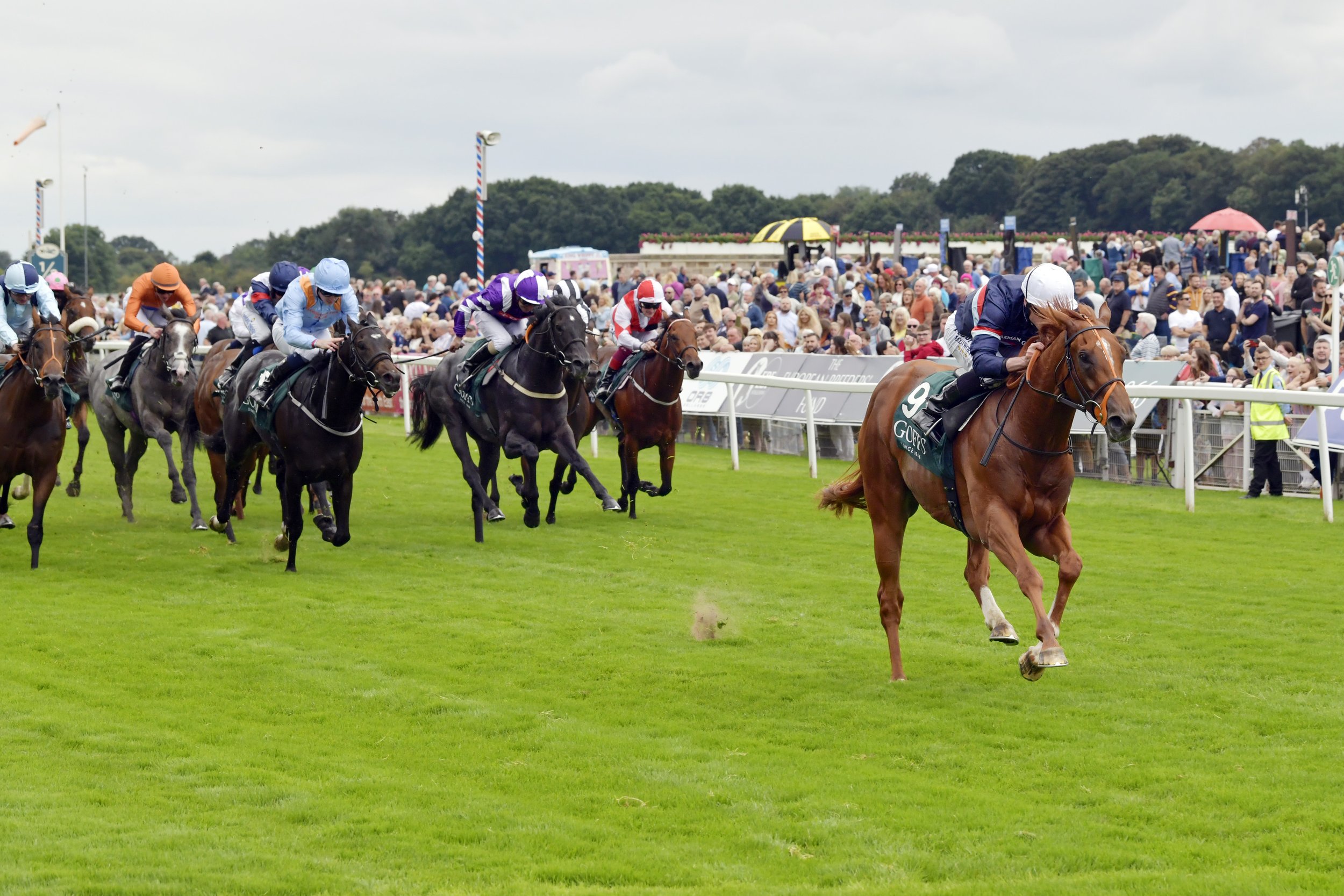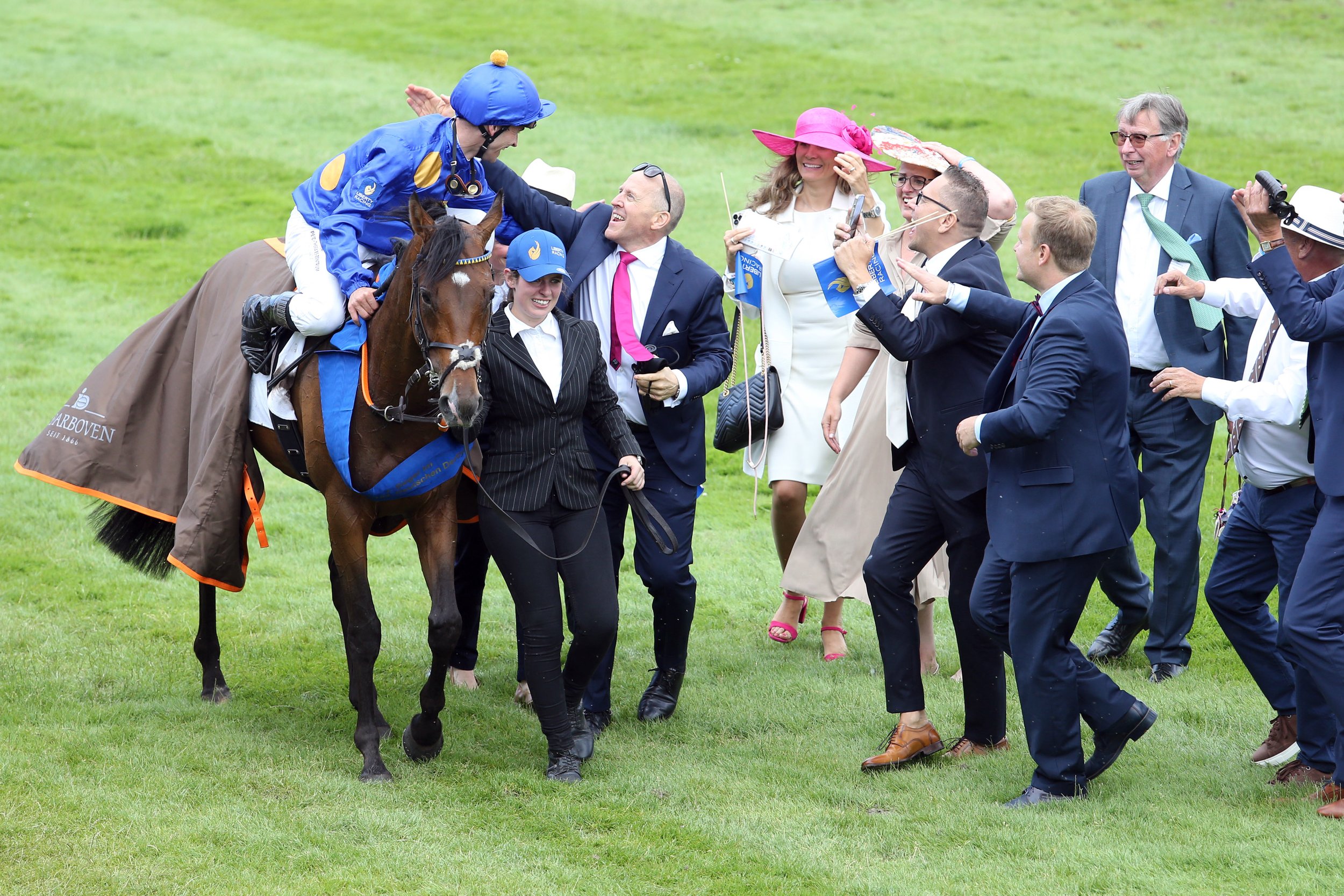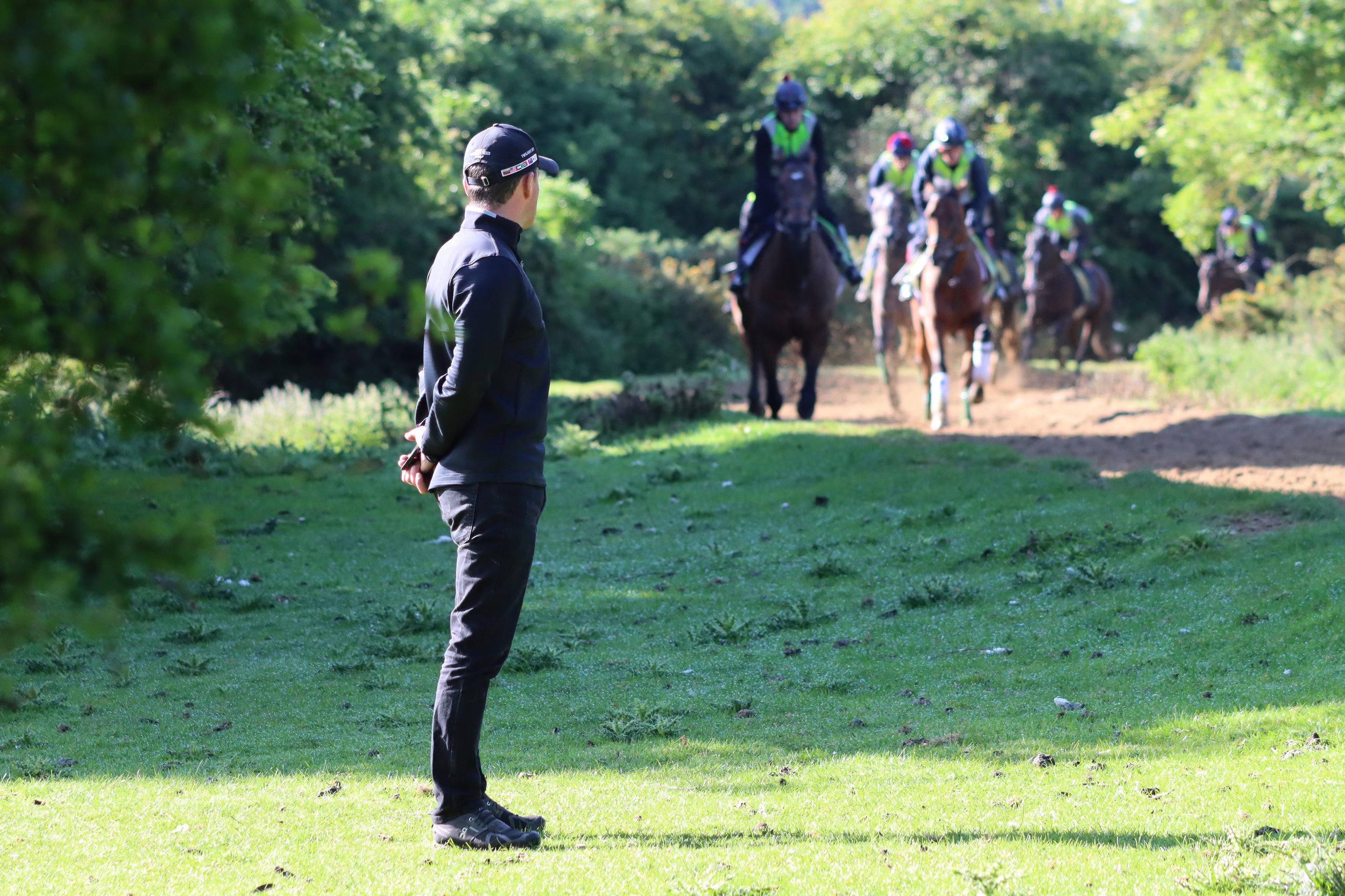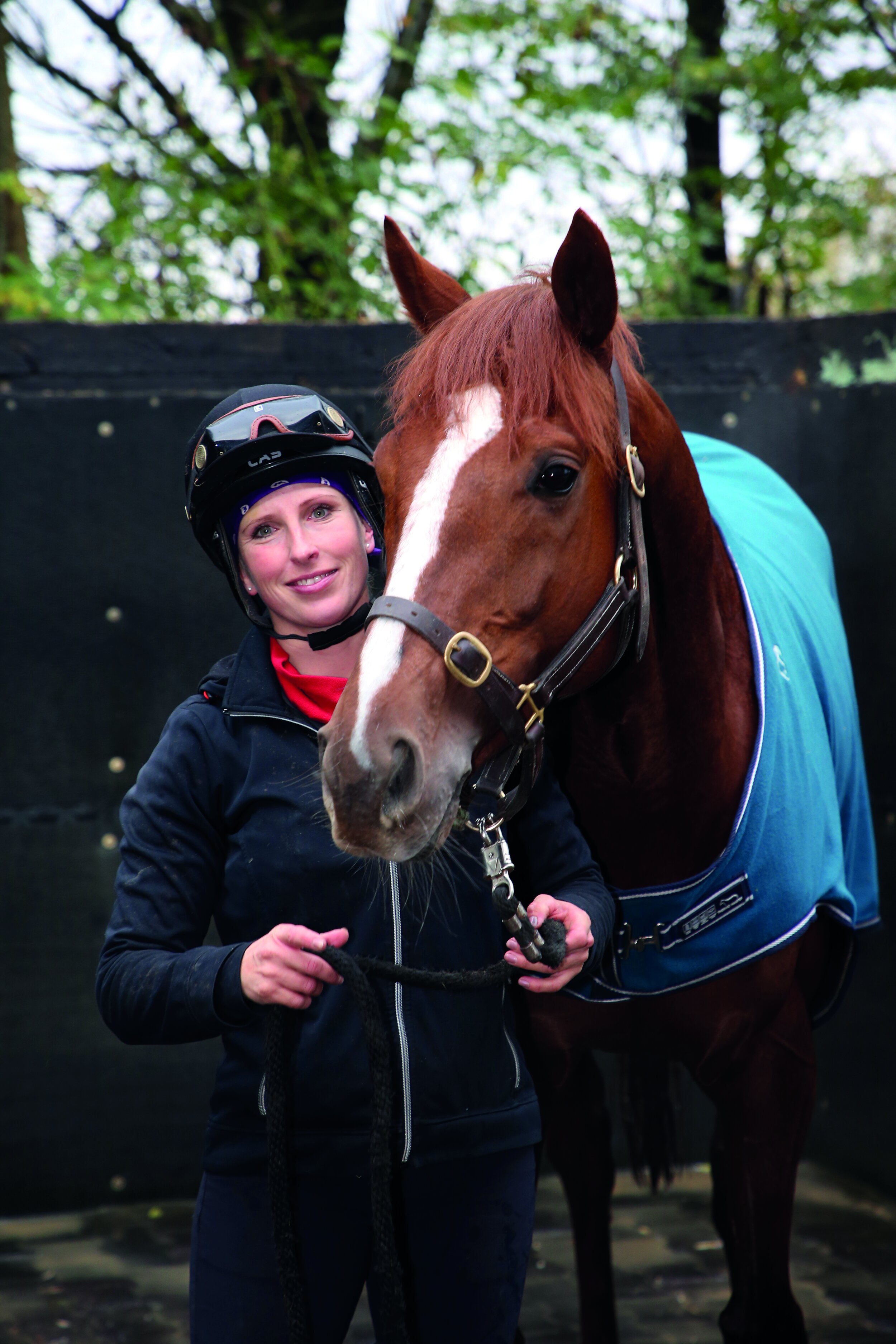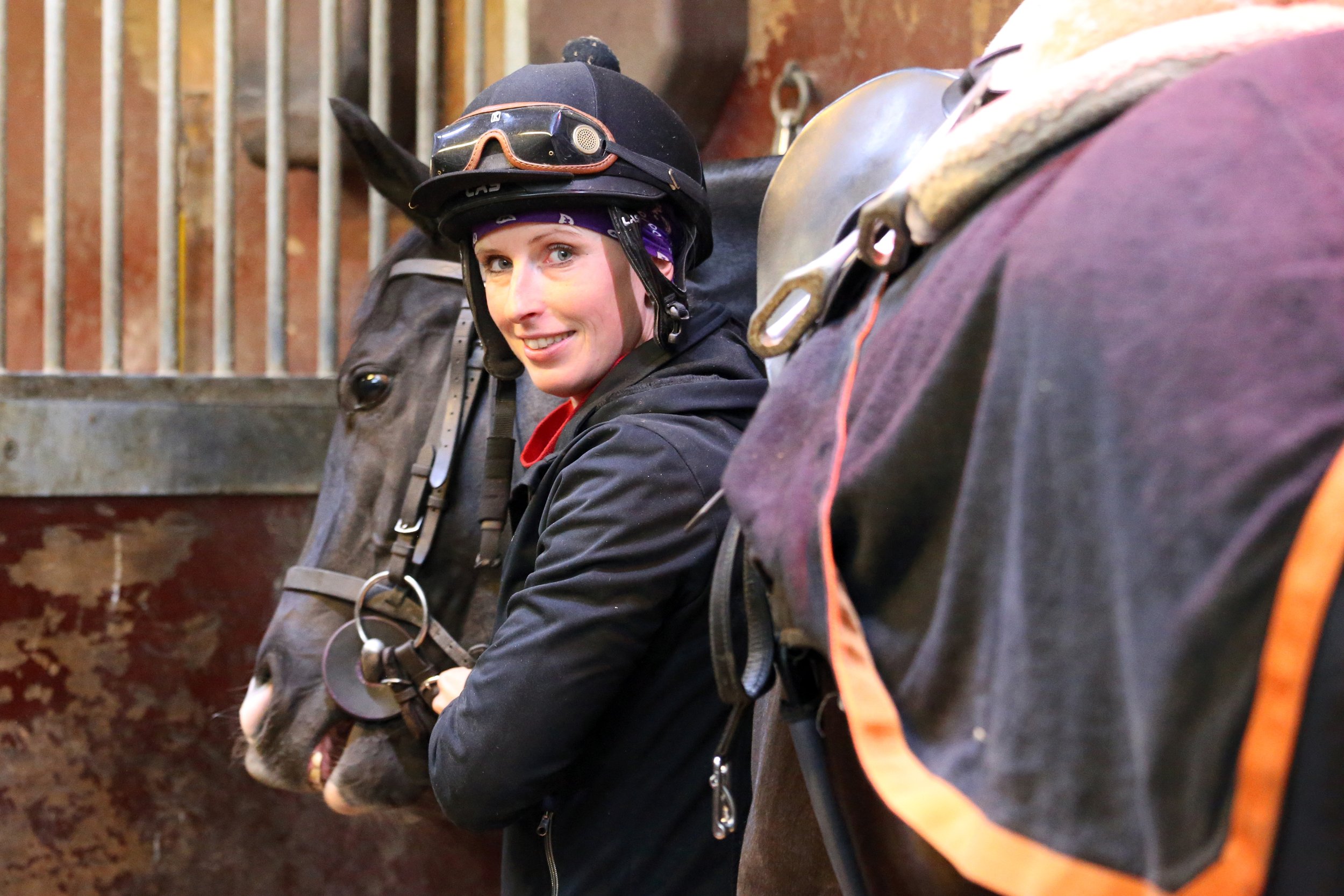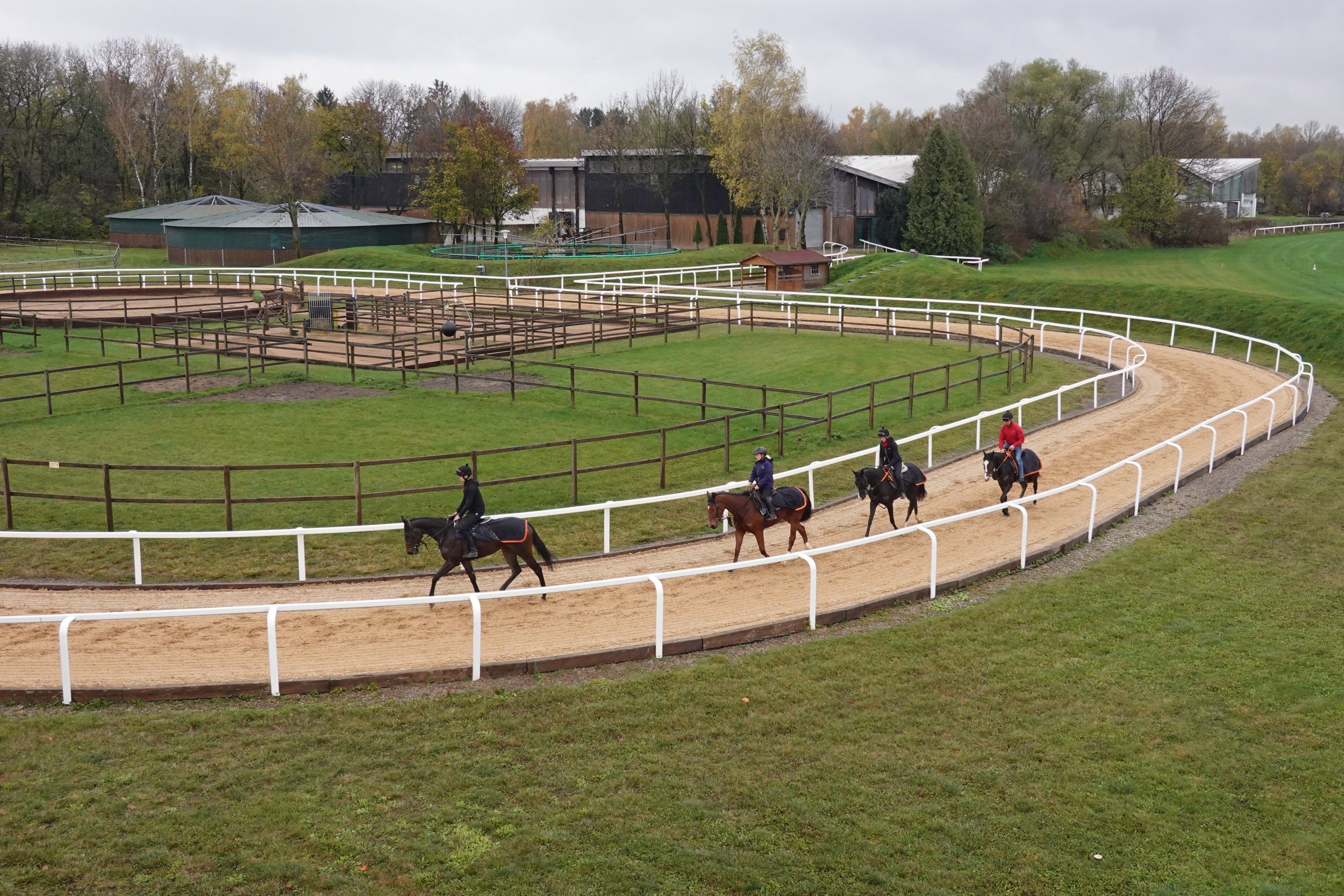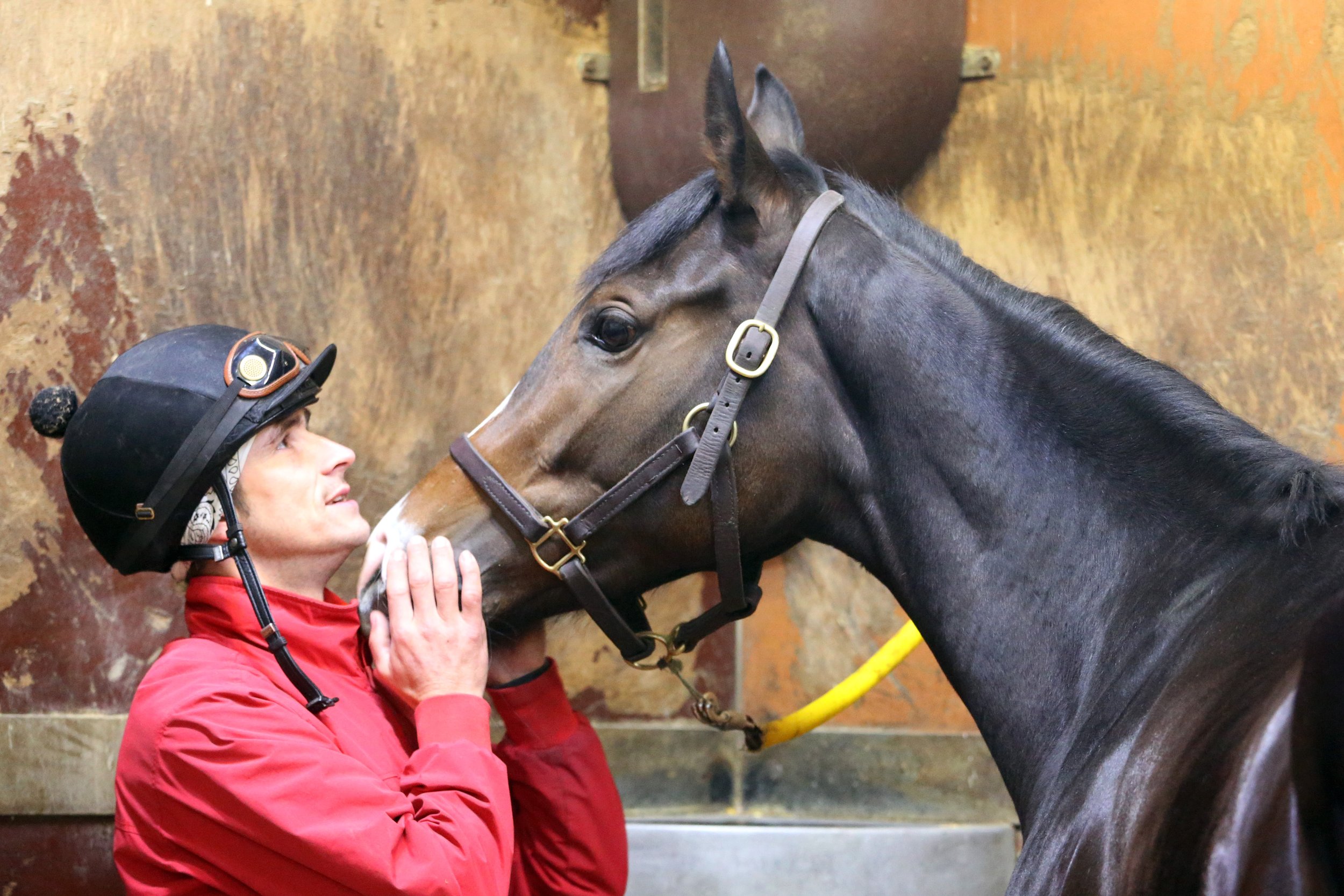Have Horse Will Travel - the international racing opportunities that trainers should be targeting this autumn
Ireland
The Irish Champions Festival takes place at Leopardstown and the Curragh 13th and 14th September respectively. The Curragh boasts the richest day of its year, with a card worth over €2.5m (£2.10m) in total. The highlights are the €600,000 (£503,865) Gp.1 Irish St Leger for three-year-olds and up, the Gp.1 Moyglare Stud Stakes and Gp.1 Vincent O’Brien National Stakes for juveniles and Gp.1 sprint The Flying Five Stakes, each worth €400,000 (£335,900).
The €200,000 (£168,000) Gp.2 Blandford Stakes, the €250,000 (£210,000) Tattersalls Ireland Super Auction Sale Stakes and two Premier Handicaps each worth €150,000 (£126,000) complete the card.
On the opening day at Leopardstown, the nine-race card features five Group races, including the €1.25m (£1.05m) Gp.1 Irish Champion Stakes 2000m (10f), the €400,000 (£335,900) Gp.1 Matron Stakes, €200,000 (£168,000) Gp.2 Solonaway Stakes, €150,000 (£126,000) Juvenile Stakes, €100,000 (£84,000) Gp.3 Tonybet Stakes, the €100,000 (£84,000) Ingabelle Stakes and two Premier Handicaps each carrying €150,000 (£126,000).
In addition to the Irish Champions Festival, the Autumn Racing Weekend will be held at the Curragh 27th and 28th September, which includes the 1400m (7f) €1m (£850,000) Goffs Million, the richest race for two-year-olds in Europe, and the richest handicap in Europe the 3200m (16f) Irish Cesarewitch, worth €500,000 (£425,000). The meeting will also include the Gp.2 Beresford Stakes (€120,000/£101,700) 1600m (8f) for juveniles, celebrating its 150th anniversary, 1200m (6f) Gp.3 Renaissance Stakes (€60,000/£50,800), and 1400m (7f) Gp.3 Weld Park Stakes (€60,000/£50,800).
Irish jumps series
For National Hunt runners, a series of seven 3300m (2m1f) 10-hurdle Irish Stallion Farms EBF Academy Hurdle races will be run in Ireland from October to December. The first is at Cork on 12th October, followed by Fairyhouse 4th October, Punchestown 13th November, Cork 23rd November, Navan 6th December, Naas 15th December and concluding at Leopardstown 29th December.
The races are open to three-year-olds which have not had any previous run under either Rules of Racing or I.N.H.S. Rules other than in Academy Hurdle races. Horses that run in any of the seven races can continue their careers in bumpers, maiden hurdles or Point-to-Points.
Jonathan Mullin, Director of Racing at HRI, explains, “Each of the races offer a Sales Voucher, similar to the IRE incentive for the owners of any eligible Irish-bred horse which wins or is placed either second or third. Each winning owner will receive a €5,000 voucher while the owners of the runner-up and the third-placed horses will each receive €3,000 and €2,000 respectively.”
Additionally, all seven races are part of the Weatherbys National Hunt Fillies Bonus Scheme, so three-year-old Irish-bred fillies that win an Irish EBF Academy Hurdle in 2025 will be awarded an additional €7,500 bonus on top of the race prize money and will still be eligible for the €5,000 scheme bonuses available if subsequently winning a bumper or a steeplechase, but not a maiden hurdle.
Germany
This season, Deutscher Galopp introduced 12 premium handicaps and 15 Premium Racedays, which included seven Group 1 racedays, guaranteeing at least €15,000 (£12,500) in handicaps and maiden races on those days.
The BBAG Auktionsrennen at Mülheim 4th October is worth €52,000 (£43,600), run over 2000m (10f) for three-year-olds offered as yearlings at the 2023 BBAG Sale, while at Krefeld 15th October is the €55,000 (£46,000) Gp.3 Herzog Von Ratibor-Rennen for two-year-olds, over 1700m (8.5f).
The Berlin-Hoppegarten card 3rd October is one of the Premium Racedays and as well as including the 2000m (10f) Gp.3 Preis Der Deutschen Einheit, €55,000 (£46,000) for three-year-olds and up, there is also a 1400m (7f) BBAG Auktionsrennen for three-year-olds offered as yearlings at the 2023 BBAG Sale, and a support card of seven other races from €15,000 (£12,500) to €22,000 (£18,500). Similarly, 19th October at Baden-Baden sees a nine-race card with the guaranteed minimum that also features the Gp.3 €155,000 (£130,000) Preis Der Winterkönigin for two-year-olds over 1600m (8f), and the Gp.3 Herbst Trophy €55,000 (£46,000) over 2400m (12f) for three-year-olds and up.
The 26th October Hannover Premium card includes the €55,000 (£46,000) Gp.3 Herbst-Stutenpreis over 2200m (11f) for three-year-olds and up and two €25,000 (£21,000) juvenile races over 2000m (10f) and, for fillies only, 1400m (7f). The Premium Racedays conclude at Munich 8th November, where the feature is the Gp.1 Grosser Allianz Preis Von Bayern over 2400m (12f) worth €155,000 (£130,000), and another €52,000 (£43,600) BBAG Auktionsrennen, this time for two-year-olds over 1600m (8f) offered as yearlings at the 2034 BBAG Sale.
Sweden
Sweden’s showcase takes place at Bro Park 12th September with a card that includes the Gp.3 Stockholm Cup International (Gp. 3) over 2400m (12f) for three-year-olds and up and worth SEK 1,000,000 (€91,700 / £76,900). The three Listed races on the support card are each worth SEK 550,000 (€50,500 / £42,350) and open to three-year-olds and up, namely the Bro Park Sprint Championship 1200m (6f), the Tattersalls Nickes Minneslöpning 1600m (8f) and the Lanwades Stud Stakes for fillies 1600m (8f).
Later Listed opportunities for three-year-olds up, each worth SEK 400,000 (€36,700 / £30,800), are the 2400m (12f) Skånska Fältrittklubbens Jubileumslöpning and the Peas and Carrots Mile over 1600m (8f) at Jägersro Galopp 5th October, and the 2100m (10.5f) Songline Classic at Bro Park 26th October.
Spain
The highlight of the Spanish season is Champions Day 19th October in Madrid, with a card that includes the Gran Premio Memorial Duque de Toledo over 2400m (12f) for three-year-olds and up, with a value of €50,000 (£42,000) and the Gran Premio Ruban over 1200m (6f) worth €40,000 (£33,500). The €40,000 (£33,500) Gran Criterium for two-year-olds is run over 1600m (8f) 26th October.
British Champions Day
Opening a card that features the British Champions Long Distance Cup (€590,000/£500,000), the British Champions Sprint Stakes ((€590,000/£500,000), the British Champions Fillies and Mares Stakes ((€590,000/£500,000), the Queen Elizabeth II Stakes (€1.36m/£1.15m), the Champion Stakes (€1.53m/£1.3m) and the 1600m (8f) Balmoral Handicap (€295,000/£250,000) is the newly-introduced Two-Year-Olds Conditions Race, worth €295,000 (£250,000), taking the total prize money on the day to €5.13m (£4.35m). Open to two-year-olds, the 1200m (6f) conditions race, like all races at this distance at Ascot, will be run over the straight course.
Turkey
The Jockey Club of Türkiye hosts seven international races in Istanbul at Veliefendi Racetrack, as part of the International Racing Festival run on the first weekend in September. The highlights are the €62,650 (£53,400) 2000m (10f) Gp.2 Anatolia Trophy for three-year-olds up, €190,000 (£162,000) Gp.2 1600m (8f) Topkapi Trophy for three-year-olds up, the €98,700 (£84,150) Gp.3 1200m (6f) Queen Elizabeth II Cup for two-year-olds, €197,500 (£168,400) Gp.3 2400m (12f) Bosphorus Cup for three-year-olds up and the Gp.3 1600m (8f) €142,400 (£121,400) Istanbul Trophy, entries closing 6th August. There is a transport subsidy for international races, $18,000 for round-trip per horse arriving from the continents of America (North and South), Oceania, Africa and Far East countries, €12,000 for round trip per horse arriving from Europe and United Arab Emirates. Any horses scratched from the race after arrival by veterinary report will still receive transportation subsidy. The Gp.3 Malazgirt Trophy for purebred Arabians over 1600m (8f) will also be part of the card.
USA
Kentucky Downs is home to America's only European-style 2000m (10f) all turf racecourse, hosting just seven days racing from 28th August to 10th September, entries closing from 16th August, when emailed expressions of interest must also have arrived for the invitationals. The feature races are the $3.5m (€3m/£2.6m) Gr.3 Nashville Derby Invitational over 2400m (12f) for three-year-olds, the $2.5m (€2.19m/£1.86m) Gr.3 1600m (8f) Mint Millions Invitational and the 2400m (12f) Gr.2 Kentucky Turf Cup Invitational of the same value which is also a "Win and You're In Breeders' Cup Turf" race. Both races are for three-year-olds and up.
Carrying $2m (€1.75m/£1.48m) each are the Gr.3 Kentucky Downs Ladies Turf for fillies and mares three-year-olds and up over 1600m (8f), the Gr.2 Kentucky Downs Ladies Turf Sprint 1200m (6f) for fillies and mares three-year-olds and up, the Gr.1 1200m (6f) Franklin-Simpson Stakes for three-year-olds, the Listed 1600m (8f) Gun Runner for three-year-olds, the Gr.2 1200m (6f) Music City Stakes for three-year-old fillies, the Gr.3 2000m (10f) Kentucky Downs Ladies Marathon Invitational for three-year-olds and up fillies and mares, the Gr.3 2000m (10f) Dueling Grounds Oaks Invitational three-year-old fillies, and the Gr.2 Kentucky Downs Turf Sprint 1200m (6f) for three-year-olds and up which is another of the "Win and You're In Breeders' Cup Turf Sprint Division” races.
Each carrying purses of $1m (€870,000/£738,000) are the Bowling Green Gold Cup Invitational 3200m (16f) for three-year-olds up, the 1600m (8f) Listed Kentucky Downs Juvenile Fillies, the 1200m (6f) Listed Kentucky Downs Juvenile Sprint, the 1600m (8f) Listed Kentucky Downs Juvenile Mile, and the 1200m (6f) Untapable Stakes for two-year-old fillies. The Listed Tapit Stakes over 1600m (8f) for three-year-olds up heads three races worth $500,000 (€437,000/£370,000), alongside the 1600m (8f) NTL Tight Spot Overnight Handicap for three-year-olds up, and the 1600m (8f) Listed One Dreamer for fillies and mares three-year-olds up. Maiden races, already the richest in the world, carry €181,000 (€158,000/£133,300) per race.
“We want to build the Nashville Derby into a race that American and European horsemen alike point to and buy horses for,” says Ron Winchell, co-managing partner of Kentucky Downs with Marc Falcone. “We’ve positioned the Nashville Derby so that it fits into a big-money circuit for three-year-old turf horses.”
The 42nd running of the Breeders’ Cup will be held for a fourth time in Del Mar, California, on the edge of the Pacific Ocean in San Diego “where the turf meets the surf”. Consisting of 14 Grade 1 races with purses and awards totalling more than $31m (€27.11m/£22.97m), the meeting takes place Friday 31 October and Saturday 1st November.
“Our return to Del Mar in back-to-back years marks the continuation of a wonderful collaboration and successful partnership, both with our friends at the track and with the greater San Diego area,” says Drew Fleming, President and CEO of Breeders’ Cup Limited. “We look forward to once again gathering where the turf meets the surf as the world’s best thoroughbreds put on an incredible show.”
“We couldn’t be more excited about hosting back-to-back Breeders’ Cup World Championships and welcoming the very best in international racing back to the town of Del Mar and the greater San Diego area,” said Joe Harper, CEO of the Del Mar Thoroughbred Club. “The Breeders’ Cup represents the pinnacle in world-class racing and the organisation’s willingness to return here again is a testament to the quality of our racing facilities, our idyllic weather, and the warm hospitality shown to our visitors by the local community.”
With 14 championship races held over two days, Future Stars Friday sees the two-year-old championships run for purses upwards of €931,130 (£783,500) and €1.9m (£1.6m). Saturday boasts nine races, culminating with the €6.5m (£5.5m) Gr1 Breeders’ Cup Classic. The “win and you’re in” series consists of 69 of the best races from around the world, from June to October, awarding each winner an automatic and free entry into the Breeders' Cup World Championships.
Bahrain
The Bahrain Turf Series is fairly new to the calendar and has seen just five renewals to date. Running from December through to February, each race carries prize money from €73,750 (£62,850) up to €91,880 (£78,200) with total and the series is designed to attract international runners rated 85-100 to compete against local Bahrain-based horses.
“We believe the time is right to build on the success of the Bahrain Turf Series and expand the international programme to incorporate our season’s premier races,” explains His Highness Shaikh Isa Bin Salman Bin Hamad Al Khalifa, Chairman of the Bahrain Turf Club. “Our most prestigious races, including the Crown Prince’s Cup and the King’s Cup, fall within the Bahrain Turf Series calendar, and are intended to make racing in Bahrain an even more attractive and compelling proposition for international visitors.”
In total, the Series of sprint and middle-distance races comprises of 12 races, six in each division, with each race carrying bonus prizes for the horses accumulating most points in their respective division.
At time of going to press the dates and 2025/26 prize monies were not available, but last year saw significant increases. In December are two 1000m (5f) and two 2000m (10f) races for horses rated 84-100 and a 1200m (6f) and 2000m (10f) race for those rated 80-100.
In January there are two conditions races, over 1000m (5f) and 1800m (9f). February, when the season concludes, sees opportunities for horses rated 80-100 at 1000m (5f), 1200m (6f), 1800m (9f) and 2000m (10f). For those seeking black type, the 2000m (10f) Gr2 Bahrain International Trophy in November for three-year-olds and up is establishing Bahrain as a premier horseracing destination. Run on turf, in 2024 the race was worth €921,858 (£785,315) in total, with €553,115 (£471,178) to the winner.
Entries close 2nd October with supplementary entry stages later in October, but there are three 'Automatic Invitation' races, for the first, second and third from The Royal Bahrain Irish Champions Stakes and the Gp.3 Strensall Stakes at York. The Bahrain Turf Club will provide air tickets for overseas connections and hotel accommodation on a room only basis. Shipment of invited horses will be arranged and paid for by the Bahrain Turf Club.
Australia
The Melbourne Cup Carnival needs no introduction and the Cup itself is only one of 10 Gp.1 racedays during the 22-day season at Flemington. The 3200m (16f) Gr1 Melbourne Cup will be worth A$8.66m (€4.93m / £4.14m) this year, with prize money down to 12th.
During the week there are three €1.8m (£1.6m) weight-for-age Gr1s, the 2000m (10f) Champion Stakes, 1600m (8f) Champions Mile and the 1200m (6f) Champions Sprint. “It is always a great thrill to host international connections who make the journey to Melbourne,” Leigh Jordon, the VRC Executive General Manager, tells us.
More recently the Sydney Everest Carnival held at Royal Randwick and Rosehill Gardens has competed for equal attention, running from 21st September to 9th November, and boasting the world’s richest race on turf, The Everest, over 1200m (6f) in mid-October at Royal Randwick and worth A$20m (€11.3m / £9.5m). The opening day at Royal Randwick features two weight-for-age races, each with a total prize of €615,840 (£520,265) for three-year-olds and up, The 7 Stakes 1600m (8f) and the Gp.2 1100m (5f) Shorts. Randwick later hosts the iconic 1600m (8f) Epsom Handicap, a Gp.1 worth €924,000 (£780,500) and on the Everest supporting card is the €3m (£2.6m) Gp.1 King Charles III Stakes over 1600m (8f).
At Rosehill Gardens, the Hill Stakes over 2000m (10f), and 1800m (9f) Five Diamonds each carry a purse of €1.2m (£1m), with the €6.2m (£5.2m) Golden Eagle over 1500m (7f) the showpiece in November.
Japan
The JRA offers travel incentives for particular overseas horses for Group 1 races and for invited overseas horses for the Japan Cup. The JRA provides air transport costs for the horse and two attendants, the owner, trainer, jockey, and their spouse/partner, and five nights’ accommodation at a JRA designated hotel.
All Japanese Gr.1s are free to enter, or by free invitation, and carry the same declaration fee of €20,200 (£17,500), with significant bonuses from first down to last for the participating winners of designated Gr.1 races globally. The 2400m (12f) Japan Cup is run at Tokyo in November for a purse of €7.3m (£6.3m), Also in November, at Kyoto, the 2200m (11f) Queen Elizabeth II Cup for fillies and mares carries a purse of €1.9m (£1.6m), and The Mile Championship is worth €2.7m (£2.3m). Run on dirt at Chukyo Racecourse, the 1800m (9f) Champions Cup has a total value of €1.7m (£1.5m).
The different incentives available across Europe this summer for those in search of prize money and black type success
Article by Lissa Oliver
In February, the European Pattern Committee (EPC) announced changes to the 2024 European programme of Flat Black-Type races. The EPC sanctioned a total of 826 Black-Type races (838 in 2023), comprising 416 Group races (418 in 2023) and 410 Listed races (420 in 2023). Five Pattern races have been downgraded in 2024, with a further 11 Listed races losing that status.
Jason Morris, Chair of the EPC, explained, “This year will see another contraction in the number of Pattern and Listed races to be staged throughout Europe, with the total number having declined from 852 races in 2022 to 826 in 2024. The European Pattern Committee continues to enforce the most stringent international quality control measures so that the racing and breeding industries can have the utmost confidence in the quality of European Black Type.”
This leaves trainers rethinking traditional routes to Black Type, but at the same time adding new avenues, some of which could lead to some interesting destinations. The EPC approved an application from Denmark to stage a new Black Type race in 2024, with the Golden Mile at Klampenborg over 1600m (8f) for three-years-olds and upwards in May being upgraded to Listed status and carrying a purse of €46,749 (£40,000).
In Ireland, the Salsabil Stakes, a 2000m (10f) race for three-year-old fillies at Navan in April, has been upgraded from Listed to Group 3. Ireland will also stage a new Listed race for three-year-olds over 2400m (12f) at Gowran Park 27th July, the Marble City Stakes worth €46,749 (£40,000).
Flagship races in Poland and Spain
Although no new Listed race applications have been received from emerging racing nations, the EPC noted the strong first Listed edition of the Wielka Warszawska in Poland in 2023. Run over 2600m (13f) at Sluzewiec Racecourse 6th October, for three-year-olds up, it carries a prize of €111,138 (£95,092).
The €85,000 (£72,728) Gran Premio de Madrid in Spain also continues to perform well after being allocated Listed status by the EPC in 2022. It’s run at Madrid over 2500m (12.5f) 22nd June for three-year-olds up.
These were created through the recent Flagship Race scheme by the European and Mediterranean Horseracing Federation (EMHF) and EPC, allowing countries with no Black Type races to apply for a single Flagship race which qualifies for Black Type at a lower rating level. This provides horses with a slightly easier Black Type opportunity, by 2.2kg (5lbs). It also opens up new and often interesting destinations for owners and team.
Morocco
Dr Paull Khan, Secretary-General of the EMHF, explains, “The quality control that is applied to European Black Type is the most stringent in the world. This is good, of course, because everyone recognises the strength of European Group and Listed races. But, on the other hand, countries with less-rich racing industries have long found it hard to establish races which attract the necessary quality of runners to qualify for Black Type. Essentially, for most race types, the average ratings of the first four finishers must be at least 100. Two years ago, the EMHF and EPC devised the Flagship Race scheme, under which countries with no Black Type races can apply for a single Flagship race to be given Black Type based on average ratings of the first four finishers being 5lbs lower than would normally be the case. In simple terms, this means that trainers with horses up to 5lbs shy of normal Listed Race standard stand a reasonable chance of attaining black type when targeted at these races.
“There is a ripple effect which is of benefit to trainers,” Dr Khan points out. ”Other countries are looking to join the party, and in order to attract the necessary quality of entries - particularly from abroad – are ploughing money into their candidate races, and are often offering attractive travel incentives, too. Even if these races have not yet attained their Black Type status, they can still be immensely attractive propositions.”
Top of the list in this respect is Morocco’s Grand Prix de la Sorec. The 10th renewal of the Morocco International meeting will be held on the weekend of 16th and 17th November 2024 at the Casablanca-Anfa racecourse, a dirt track. This prestigious 14-race meeting plays a major role in promoting the Moroccan horseracing industry internationally and includes eight international races worth €1m in total. Sunday is devoted to Purebred Arabians, with over €500,000 in prize money for the four Black Type races.
Saturday is an all-thoroughbred card and of interest here is the feature €123,000 Grand Prix de la Sorec, 2400m (12f) for three-year-olds up. Entry is €600 by 31st October, free to declare. Also on the card is the €71,600 Grand Prix des Eleveurs for three-year-old fillies, over 1750m (8.75f) and the €61,600 Grand Prix des Proprietaires for three-year-old colts, over 1900m (9.5f). Casablanca-Anfa racecourse provides a children's area, entertainment and excellent facilities for visiting owners and trainers. The Cité du Cheval is the 87-hectare training centre on the outskirts of Casablanca, 15 minutes from Casablanca airport and 30 minutes from the racecourse, with 400 boxes, several training tracks, a farriery centre, two restaurants and a housing and catering area for staff.
International runners will have their flights, via the BBA, paid for, or up to €3,000 toward overland transport. Flights, hotel accommodation and all transfers are provided for two owners, the trainer and guest, and the jockey. Hospitality includes lunch at the racecourse on both days and dinner at the Gala Evening on Saturday.
As Dr Khan points out, “Another factor here is the ‘racing tourism’ element. The exotic location of these races provides an additional appeal for owners and trainers who want to soak up the fantastic experience of racing in different cultures.”
Turkey
Turkey and its International festival on the first weekend of September at Veliefendi Racetrack, Istanbul, has for long been a popular destination, particularly for British trainers. Since Brexit, however, the issues involving a Third Country have deterred British runners, leaving the races more open for other European runners. What is instead happening is that two valuable €240,000 (£208,000) Group races have been wholly contested by locally-trained horses, the 2023 Bosphorus Cup attracting just five runners.
The International Bosphorus Cup has this year been downgraded to Group 3, but remains an attractive proposition. Run on turf over 2400m (12f), the €240,000 (£208,000) race is open to three-year-olds up. With the same prize money, the 1600m (8f) International Topkapi Trophy is another Group 3 for three-year-olds up that last year attracted no foreign runners. And the same applies to the fillies only Group 3 International Istanbul Trophy over 1600m (8f), worth €127,000 (£108,645).
Entry for the International meeting is by 2nd August, and a very generous travel subsidy is available to foreign runners, including $18,000 to horses arriving from the continents of America (North and South), Oceania, Africa and Far East countries. Up to €12,000 is available to European and UAE runners.
Sweden and Norway
Sweden’s 500-acre Bro Park has permanent stabling and training facilities, just over 30 minutes from the centre of Stockholm by car and a similar distance from Arlanda Airport. The two main international days are the Stockholm Cup day 15th September and the Stockholm Stora day 9th June, both branded as Super Sunday, during which the local 1000 and 2000 Guineas are also run. Run on turf at Bro Park, the Group 3 Stockholm Stora Pris is run over 1750m (8.75f) and worth €88,817 (£75,992), with a strong supporting card of the €29,309 (£25,000) Listed Bro Park Varsprint over 1200m (6f) and Listed Bloomers’ Vase 1600m (8f) for fillies, carrying the same value.
The Group 3 Stockholm Cup International over 2400m (12f) on turf carries prize money of €124,343 (£106,380) and the three supporting races each offer €58,619 (£50,151); the Listed Tattersalls Nickes Minneslöpning 1600m (8f) run on dirt, the Listed Bro Park Sprint Championship 1200m (6f) on turf, and the Listed Lanwades Stud Stakes 1600m (8f) on turf for fillies. Lanwades Stud also generously offers a free nomination to one of its stallions to the winner. The card also includes a 1400m (7f) two-year-old race on turf worth €36,859 (£31,534), the Svealandlopning. The other mentioned races are for three-year-olds up.
There are also interesting opportunities in Norway on Norsk Derby day 25th August at Oslo, as Director of Racing Liv Kristiansen tells us. ”Oslo offers a great range of both historic and modern hotels and restaurants and makes for a great long weekend with the Derby Day as a finale. The racecourse is just a 15-minute drive from the city centre and is home to most of the racehorses in Norway. On the day, there will be many runners from Denmark and Sweden as well.”
Kristiansen reminds us that it is prohibited to use the whip throughout all of Scandinavia, and in Norway jockeys are not allowed to carry a whip in races for three-year olds and older.
Germany
As an accompaniment to the familiar Pattern races in Germany, Deutscher Galopp Director of Racing Rüdiger Schmanns tells us, ”in general all races are open for foreign trained horses, even handicaps if the horses have a rating in the home country. We have good prize money options in handicaps on the so-called Premium Race Meetings, which are meetings on Sundays or Bank Holidays with at least a Group race on offer on that day. Handicaps of the best category are in total value of €20,000 (£17,103), the second best of €15,000 (£12,827), the third best of €10,000 (£8,551), and the lowest category of €8,000 (£6,841). At the Baden-Baden meetings there is usually one handicap of the day with higher prize money and in Bad Harzburg we have the so-called Super-Handicaps with exceptional prize money in the different categories, but they have an early closing stage at the beginning of April. Average prize money is the highest ever on offer in Germany at €14,200 (£12,143).”
France
Handicaps should also be on the radar in France, where France Galop is contributing heavily in the relaunch of the Quinté+ bet. As a result, the 13 Major Handicaps programme has been remodelled to restore appeal. Four Super Handicaps are now worth €100,000 (£85,519) and eight more have increased in value to €75,000 (£64139), with maximum runners raised to 20. The four €100,000 Super Handicaps cannot be on a Group 1 card and will be run on 7th April at ParisLongchamp 1400m (7f) four-year-olds up; 5th May ParisLongchamp 2000m (10f) four-year-olds up; 4th August Deauville 1600m (8f) three-year-olds up; and 8th September ParisLongchamp 1850m (9f) three-year-olds up.
The dates of the €75,000 Grands Handicaps, with a maximum of 18 runners, are 2nd June Chantilly 2400m (12f) four-year-olds up; 16th June Chantilly 1800m (9f) four-year-olds up; 15th August Deauville 1200m (6f) three-year-olds up; 18th August Deauville 1900m (9.5f) three-year-olds up; 5 October ParisLongchamp 1600m (8f) three-year-olds up; 5th October ParisLongchamp 2500m 12.5f) three-year-olds up; 6th October ParisLongchamp 1300m (6.5f) three-year-olds up; 6th October ParisLongchamp 2000m (10f) three-year-olds up.
Another shake-up comes in the reduction of entry fees for Group 1 races to revitalise entries, introducing a uniform entry price of 0.65% of prize value, with the exception of the Qatar Prix de l’Arc de Triomphe and the Classic races. This lowers the entry fees for 15 Group 1 races, out of a total of 21. Trainers should note that entries have also been brought forward to earlier dates, now four weeks prior to the race.
Ireland
Horse Racing Ireland confirmed a record 395 fixtures for 2024, with an increase of €1.3m (£1.1m) in prize money, creating additional opportunities for horses at all levels. In addition, the final €1.4m (£1.2m) in capital schemes will be paid out for stableyard expansions (€0.3m) and racetrack and industry facility improvements (€1.1m), making it a more attractive proposal for visiting horses and team.
HRI, the Irish EBF and Gowran Park Racecourse have announced a significant boost to the three-year-old programme for middle-distance horses with a new Spring Series of median sires races, culminating in the €200,000 (£170,980) Irish Stallion Farms EBF Gowran Classic, 2000m (10f), the richest race ever held at the County Kilkenny course, on Bank Holiday Monday 3rd June. The race is designed to attract three-year-old middle-distance horses with a median price of no more than €75,000 (£64,121). The winner will receive an automatic free entry into the Dubai Duty Free Irish Derby at the Curragh on 30th June.
The series, with total prize money of €330,000 (£282,125), will consist of six races with a minimum prize-fund of €25,000 (£21,373) per race. The Curragh, Navan and Cork will host four maiden races between them, two for fillies only, and each of these races will be restricted to runners whose sires achieved a median price of not more than €50,000 (£42,747) in 2022.
A median price of €75,000 (£64,121) will apply to runners in The Irish Stallions Farms EBF three-year-old Spring Series Race, with a value of €30,000 (£25,647) at Roscommon on 13 May. The same median price restriction will apply to runners in the €200,000 series Finale.
Racecourse Manager Eddie Scally says, “Gowran Park are really excited to host the inaugural €200,000 Irish Stallion Farms EBF Gowran Classic, the region’s richest Flat race. This race will form part of an action-packed day both on and off the track with live music and a massive family fun day. We hope the Gowran Classic will attract all the top trainers and riders from both Ireland and abroad and see for themselves the warm Kilkenny welcome.”
Irish Stallion Farms EBF already sponsor two successful series for two-year-olds, the auction and median series with 27 races in each and a combined value of nearly €850,000 (£726,712). ”We felt it important to develop a similar series for later developing middle-distance three-year-olds,” says Irish EBF Chairman Joe Foley, ”hence the Spring Series was initiated with the Gowran Classic as its centrepiece. We look forward to seeing this three-year-old series grow and develop and are delighted to support Gowran Park racecourse in particular, who are investing heavily in their facilities.”
Curragh-based trainer Willie McCreery points out, “These races are designed to be linked to the median price of the stallion, which allows everyone to participate. It offers great opportunities for middle-distance horses that needed a bit of time to mature and gives them a big target to aim at. The prize money along with the ‘win and you’re in’ to the Dubai Duty Free Irish Derby is a super incentive.”
The new series consists of the 2000m (10f) €25,000 3yo Median Auction Maiden (Fillies) at the Curragh 6th April; 2000m (10f) €25,000 3yo Median Auction Maiden at Navan 9th April; the 2000m (10f) €25,000 3yo Median Auction Maiden at Navan 27th April; the 2000m (10f) €25,000 3yo Median Auction Maiden (Fillies) at Cork 10th May; the 2000m (10f) €30,000 3yo Median Auction Winners of 1 at Roscommon 30th May; and the Gowran Classic.
If tourism is the agenda, don’t forget Ireland’s only beach race meeting at Laytown, a small seaside resort just 46km (29 miles) from Dublin. The six-race card at Laytown races is held Monday 16th September 2024 with an average of €7,000 (£6,000) to the winner.
Britain
Last year saw the introduction of high value developmental races in Britain, a scheme the BHA has expanded for 2024. From 63, there are now 84 developmental races for the Flat season worth over €3.5m (£3m) in total prize money. The initiative has been made possible by British Stallion Studs (EBF), Juddmonte, Darley and Tattersalls, as well as the BHA Development Fund and is aimed at supporting the domestic breeding industry and encouraging the purchase of young talent in Britain. The races offer enhanced prize money to horses embarking on the early stages of their racing careers.
Richard Wayman, Chief Operating Officer of the BHA, explains, “These races play a hugely important role within the race programme and yet, historically, it is an area where prize money has been behind our international competitors. It is essential that steps are taken to retain quality horses on our shores and with over 80 of these races scheduled for the coming season, this is one initiative that we believe will support this broader aim.”
The 2024 programme began with the Brocklesby Stakes at Doncaster on the opening day of the 2024 Turf season, one of 60 such races for two-year-olds. It comprises 32 Open Novice/Maiden races for two-year-olds, worth a minimum of €46,789 (£40,000); 29 Restricted Novice/Maiden races for two-year-olds, worth a minimum of €35,091 (£30,000); and 23 Open Novice/Maiden races for three-year-olds up, worth a minimum of €46,789 (£40,000).
“British Stallion Studs (EBF) are delighted to be a leading sponsor of the 2024 High Value Developmental Race programme, with a contribution of over €380,172 (£325,000), covering more than 30 races,” says Simon Sweeting, Chairman of British Stallion Studs (EBF). “One of the unique features of our prize money contributions is to encourage racecourses to ‘match-fund’; it is wonderful to see the model we pioneered and embedded, replicated by our fellow sponsors in these races.”
The EBF remains the leading sponsor of European racing and Kerry Murphy, European Breeders Fund CEO, points out, ”The EBF was set up over 40 years ago primarily to tackle the threat of less prize money in two-year-old maidens. With £3.5m total prize money and over 80 high value two-year-old and three-year-old races worth at least £30,000 from the end of March to October, there will be opportunities for all types. It is a great credit to all involved and, of course, all the British stallion farms that contribute to the EBF, and I hope will give owners and purchasers at the yearling sales plenty of incentives.”
The full race list can be seen at:
https://ebfstallions.com/wp-content/uploads/2012/11/2024-Development-Race-List-public.pdf
A 20-minute drive from Stansted Airport, Chelmsford City offers some tempting opportunities for runners from abroad. Not least is the Cardinal Condition Stakes on Saturday 6th April, a Class 2 race that is the last stop of the European Road to The Kentucky Derby, a “win and you’re in”. Run over a mile (1600m) and restricted to three-year-olds, the race is worth £100,000 (€116,953), with the winning horse receiving 30 points, ensuring a place at Churchill Downs. Second through to fifth place receive 12, 9, 6 and 3 points respectively.
“Last year Bold Act won for Charlie Appleby and he has since won a Grade 3 at Keeneland. The runner-up was the Archie Watson-trained Brave Emperor, who had won twice here as a two-year-old and he followed up with a Group 3 win in Germany next time out. Brave Emperor has since added three more Group wins and has just won the Irish Thoroughbred Marketing Cup, a local Group 2, at Doha. We are hopeful of seeing the Cardinal Condition Stakes upgraded to Listed status for next year, given the strength of the race,” says Neil Graham, Chelmsford City Racing Director.
Another imminent upgrade to hope for is the currently Listed Queen Charlotte Stakes over 7f (1400m) for fillies four-year-olds and up, run on Sunday 7th July, with prize money of £100,000 (€116,953). Graham points out, “Past winners include One Thousand Guineas heroine Billesdon Brook, Group 1 winner Highfield Princess and Soft Whisper, a subsequent Group 2 winner in Meydan. It comes a month before the Oak Tree Stakes at Goodwood and is good stepping stone, as Billesdon Brook showed. It is also Britain’s second-most valuable Listed race, behind only the Chesham Stakes at Royal Ascot.”
The third of Chelmsford City’s feature races is the £80,000 (€93,595) Listed Chelmer Fillies Stakes over 6f (1200m) for three-year-old fillies, run Thursday 2nd May. “It’s a good option for the non-stayers and it’s a race that builds on quality year on year. Last year it was won by George Boughey’s Believing, who won a Group 3 at Chantilly on her next start,” says Graham.
“We work hard on promoting our feature races, which includes ensuring a high level of prize money, and we work closely with Adrian Beaumont at the International Racing Bureau to attract foreign runners. We look to offer travel incentives to runners from abroad and we consistently offer Class 6 prize money of £7,650 (€8,949) and £9,650 (€11,288) for Class 5 races, considerably more than any other All-Weather track in Britain.
“We have 125 boxes built to the highest standard located in a quiet and secure yard, with ample room for parking and a fantastic team on hand. Paper or shavings are available.”
“We are in the process of developing a Turf track for 2025 to open up further opportunities,” adds Graham, “and a month ago we were voted one of the Top 10 racecourses in Britain, which is a nice accolade to receive and a reflection of the excellent customer experience we offer.”
Overlooking the parade ring, the exclusive Owners and Trainers Bar provides a complimentary welcome drink and light refreshments. An additional facility for Owners and Trainers adjacent to the parade ring has a fully accessible glass-walled marquee and lawn, and there is also a dedicated viewing area in the main Grandstand, fully wheelchair accessible, for owners with runners on the day.
If it’s culture and tourism of most interest, a day at Ascot is always a highlight. This season, Ascot’s total prize money has risen to €20.4m (£17.5m) including Royal Ascot at €11.6m (£10m), with no Royal meeting race run for less than €128,688 (£110,000). Entry for Royal Ascot Group 1s is 30th April and for the King George VI and Queen Elizabeth Stakes 4th June.
Conditions for the Chesham Stakes (7f 2yo’s), traditionally run on the last day of the fixture, have been altered for 2024 - with horses no longer eligible to qualify via their dam’s performance. The race will return to a stallion only qualification as the race was prior to 2019 (sire must have won over 10f+).
Hannah Parlett, Owners and Trainers Manager, tells us, ”We have received an ROA Gold Standard again for our outstanding owners’ and trainers’ facilities here at Ascot, which include dining rooms overlooking the pre-parade ring in addition to a dedicated bar in the same area, along with a superb track facing facility. There are also two dedicated viewing areas.”
Another ROA Gold Standard winner is Newbury, recognising Newbury’s continued efforts to enhance the on-course experience for owners. The OLBG Owners Club is close to the pre-parade ring beside the owners and trainers entrance. It is exclusively reserved for owners, with a private terrace.
*Euro/Sterling rates Xe.com 07/03/2024
Shared ownership
It has always struck me—as someone with a keen interest in most sports—that the lack of harmonisation around various rules and issues such as interference, jockey’s weights, and doping isn’t helpful as racing remains such a puzzle to most of the world.
This is evident too in the area of shared ownership, of syndicates, racing clubs and the developing area of micro share groups.
Never has it been more important for racing to attract fresh blood, with its core support ageing and the sport barely causing a ripple in mainstream media. Shared ownership is a foolproof mechanism for unearthing new acolytes because emotion and feeling will trump catchy slogans or slick promotional videos every time. If you want converts, having them in the parade ring as part of the inner circle and seeing their horse run and contend or win is your best bet.
Piers Winkworth, racing manager of Kennet Valley Thoroughbreds, summed it up well after Dragon Leader maintained his 100 per cent record from three runs by landing the £147,540 first prize in the Goffs UK Harry Beeby Premier Yearling Stakes at York’s prestigious Ebor meeting in August.
Dragon Leader with Ryan Moore up wins the 2023 Premier Yearling Stakes at York’s prestigious Ebor meeting in August.
“This is what syndicates are all about really—having cracks at these ultra-valuable sales handicaps with modestly bought horses,” Winkworth noted. “Dragon Leader, a £45,000 Donny yearling, goes and wins the big race by some distance under Ryan Moore. It was thrilling for all of our owners. We had about 16 people up at York to see him, and there were great celebrations after the race”.
Johnny Murtagh has participated in many such celebrations, having had a hefty number of syndicates at Fox Covert Stables since he took out a licence to train at the conclusion of a stellar riding career.
The Curragh-based conditioner secured his first Gp. 1 triumph with Fitzwilliam Racing’s Champers Elysees in 2020, and bagged his first Classic the following season when Sonnyboyliston swooped to score in the Comer Group International Irish St Leger for Kildare Racing Club.
This season, Murtagh has had runners for 11 syndicates, saddling winners for six of them. So enamoured is he with shared ownership that he has just launched a new racing club, Racing Revolution, more of which anon.
“There’s nothing better than coming back into the ring and seeing people who never thought they’d ever own a horse so happy”, reports Murtagh.
“We’ve been very lucky with Fitzwilliam. They ended up winning a G.p 1. We now have the likes of the Brunabonne Syndicate—lads from where I grew up. They’ve been so lucky with Mashhoor. He won a couple of big races (including at Gp. 3 level), brought the lads to York and Ascot, and ran on all the big days”.
The idea of the racing club came out of Mashhoor’s Listed triumph on Tattersalls Irish 2000 Guineas day at Curragh Racecourse in May. In particular, it was the reaction of Tommy Dowd, a celebrated former Gaelic footballer who led Meath to All-Ireland glory in 1996, that resonated.
“Tommy Dowd picked up the Sam Maguire as captain of Meath and he said, ‘This is the same feeling as that.’”
Dr Paull Khan, secretary-general of the European and Mediterranean Horseracing Federation summarises the overall situation brilliantly.
“In many countries (in and outside our region), racing is struggling to maintain its popularity and relevance, as societal practices and preferences shift,” notes Khan.
“Broadening the base of racehorse ownership may well prove a key weapon in countering this trend. Quite simply, the more people that have an involvement in owning a racehorse, the more our sport becomes embedded in society.
“For racing authorities, the challenge is not limited to promotion. Appropriate Rules of Racing must underpin such activity, which allow for and define co-ownership options.
“But there is also a potential downside, in that the creation of ownership entities which encompass large groups of individuals brings with it increased risks of incompetent or, yet worse, fraudulent management. Any examples of people suffering bad experiences, which are not satisfactorily dealt with, are likely to gain much publicity and have the effect of putting off future owners. So the final aspect to which racing authorities must give thought is the need for effective regulatory oversight, to minimise this risk”.
What follows is something of a potted overview of the situation in Europe, thanks to a number of different stakeholders from governing bodies to trainers and plenty more in between.
BRITAIN
Establishing a new syndicate isn’t laborious in Britain, and only the manager/syndicator must register as an owner. The members do not have to register, but an updated list of members must be provided to the BHA as well as the percentage share held by each one.
Racing clubs are focussed entirely on the experience of ownership but without having any equity in the horse or share in whatever proceeds it accrues while racing. Members pay an annual fee to enjoy most of the other benefits of ownership, on race day and while in training. Once again, only the person setting up or running the club must register.
Micro share groups are becoming more visible and are a very cheap way to become involved in racing as a tiny percentage of a share, normally a fraction of 1 percent , can be acquired for as little as £40. Like racing clubs, they are primarily experiential, though members are owners and are entitled to the equivalent cut of any money accumulated.
All forms of shared ownership in Britain are subject to a code of conduct that includes specific mandatory clauses in each written contract. Transparency and protection are the key tenets of the code. The BHA has committed to auditing a proportion of syndicate/racing club/micro share contracts to ensure compliance.
George Baker’s ‘Have horse, will travel,’ mantra has always made him attractive to shared ownership groups. The Robins Farm trainer has saddled winners all over the world and is as good a host as he is a trainer.
The Surrey-based conditioner has his own racing club, the George Baker Racing Club, which provides all the perks of an involvement in racehorses, including open house visits, parade ring passes, regular communication, picnics at Royal Ascot and Glorious Goodwood, and even a share in a prize money.
Baker joins Andrew Balding and Harry Eustace as trainers for the MyRacehorse fractional share group, making a big splash on this side of the Atlantic and having initially enjoyed stupendous success when established in America by Michael Behrens.
The relationship with MyRacehorse began with Get It and Watchya racing in Bahrain; and the ambition was rewarded by the former being awarded a victory after the winner on the day was disqualified due to a positive sample.
“The key point here is making racehorse ownership accessible to absolutely everybody in the way that it has been for a few years now and obviously in Australia, where the big syndicates have had massive success”, Baker declares.
“Like our horse (Get It) at Wolverhampton (on September 7) that won the Racing League race—a share in him was £45. The wonderful thing about a share at whatever level [is] the horse becomes your horse, regardless of whether you’ve paid a million pounds or forty pounds.
“We all know it’s the way forward because we’ve just got to get as many people as we can into this game, and of course you hope that some of them become more heavily involved in the sport and that it evolves to a longer association; but the most important thing is showing racing as a viable means of enjoyment”.
A degree of suspicion has lingered around micro share operations, but Baker is happy to go to bat for MyRacehorse.
“I can’t speak for any of the other micro share entities, though obviously I’ve heard rumours of numbers not quite stacking up or that horses worth ‘x’ have been marketed for ‘x + y + z’; but that’s not something I can be quoted on because I haven’t had intimate involvement or knowledge.
“I know from the MyRacehorse perspective, they are wholly transparent and very keen to be treated as you would treat a security in the stock market. They want to create a secondary market so people can trade in and out of their shares.
“People demand absolute transparency and absolute integrity and from my experience, clearly that’s what MyRacehorse have based their brilliant business on in America and Australia; and they’re trying to bring the same criteria here. And that’s absolutely correct. I don’t want to be involved with any organisation or micro share entity where there’s a level of suspicion around the numbers. And that’s why MyRacehorse is creating a niche and an attractive market”.
Baker returns to Get It and Wolverhampton to ram home his point about the impact feeling a winner can have regardless of financial outlay.
“There was one of the guys in the winner’s enclosure who’d won a share that night in a race card competition that MyRacehorse had organised with the Racing League. And there he is in the winner’s enclosure being photographed with (jockey) Paul Mulrennan and the horse. The guy was almost in a state of shock, but he was absolutely loving it”.
IRELAND
Ireland is among the most proactive European jurisdictions for the promotion and growth of multiple ownership. Figures from 2022 indicate that the number of syndicates increased by 24 per cent to 825, comprising 8,030 people.
The number of racing clubs increased by 6 per cent, comprising 1,683 members.
People can join existing syndicates or racing clubs or establish their own. Syndicates in Ireland comprise 3–100 people, while racing clubs can have an unlimited number of members.
The above figure for syndicates also includes the evolving fractional ownership model, with MyRacehorse having horses in training with Joseph O’Brien and Michael O’Callaghan.
“It is a great way to dip your toe in the water and see if it is the pastime for you,” says HRI’s owner development manager, Amber Byrne of shared ownership, who adds that plenty with the means to indulge in sole ownership prefer syndicates as a means of spreading their risk or because they derive more enjoyment from them.
HRI maintains a register of racehorse owners and can void or suspend owner registrations. The onus falls on the agent to ensure the syndicate/club and its members complies with the rules of racing, HRI directives, owner eligibility policy etc. Unlike the BHA, they do not have a specific code of conduct in place but advise that all syndicates and clubs provide them.
Agents must be registered as full owners and provide necessary ID, bank details etc., while a full list of membership including addresses and contact details and shares held must be supplied and continuously updated. Syndicates/clubs must declare if they are selling shares publicly and declare the maximum number of shares available in a particular horse.
Jack Cantillon, founder of the hugely popular Syndicates.Racing, says HRI has it just right in terms of regulation and oversight.
“We recently registered in France, and it took over a month for our application to be successfully processed; so we should be thankful for how quick it has been for us to do so in Ireland”, Cantillon relates. “We also are registered in New York, and they even wanted my fingerprints before we got over the line! Ireland strikes a balance of enough protections while not over burdening with ridiculous red tape.
“Syndicates are the backbone of building the pipeline of ownership of racehorses throughout the world”, he continues. “We’ve had incidents of people taking a €200 share as their first share in a racehorse and progressing to owning horses worth €100,000 on their own. It’s an amazing journey to see in full sight and something that’s incredibly rewarding”.
Syndicates.Racing has enjoyed spectacular success in a short period in both codes, with runners and winners at a host of major meetings and venues, including graded-winning mares Cabaret Queen and Grangee. Their trainers include Willie Mullins, Joseph O’Brien, Henry de Bromhead, Jessica Harrington, Gavin Cromwell, Peter Fahey, John McConnell, Jack Davison and the aforementioned Johnny Murtagh. They also have horses in training in Britain and America.
Grangee with Jack, John and Tom from Syndicates.Racing.
“We have been blessed with over a thousand owners that have gotten involved in Syndicates.Racing since its inception and bringing so many of them to the winner’s enclosure has been a hugely rewarding thing… If you do have a positive experience, there’s very few more rewarding experiences of intimate involvement that you can get in any sport”.
As mentioned earlier, Murtagh is such a believer in the benefits of shared ownership that he has just launched his own racing club.
“You’d love people to have a good experience of racing. They’re going to be racing, but they’re going to see behind the scenes as well—even things like a horse being shod or going through the stalls; the ins and outs of JP Murtagh on a weekly basis with a horse ready to run. You’ll have a morning on the gallops, a few get-togethers. I think there’s going to be a great take-up and plenty of entertainment.
“There’s a bit more work, but I only speak to the racing manager and they keep everyone else informed. You’re going to have to employ somebody to take videos and keep it updated every day. I want people to see what’s going on and to feel part of it.
“You like to promote the game as best you can and show it in a good light and maybe in a way that people with some bit of interest want to see more and you never know what it leads to. One fella might say, ‘I enjoyed that; can you buy me a horse?’ Rather than jumping into it straight away, they get a good feel.
“I think it’ll work. We’ve a good horse, and we’ve a plan for the horse. We have everything in place, ready to go. I think people will like to be part of it.
While there is “a bit involved” in setting Racing Revolution up, “Murtagh found HRI very helpful. Ireland’s governing body is full square behind shared ownership as a means of growing the sport and industry.
“The promotion of shared ownership is central to our domestic marketing strategy”, Byrne emphasises. “Syndicates and clubs are key in introducing the ownership concept. We see it as an affordable entry stage into ownership and a way for those interested in racing to get closer to the action and behind-the-scenes access.
“For the most part our domestic marketing promotion concentrates on highlighting multiple ownership. There is no other sport that allows the kind of access that ownership offers and allows fans to get fully immersed in a sport that they love”.
Cantillon sees one area of potential improvement.
“I think we as an industry should invest in a comprehensive customer relationship management system for our owners. We should take advantage of affordable technology available to improve owner experience tenfold. Send a special deal to owners on their birthday, invite them back to the anniversary of their winner last year, issue tickets digitally so there’s no mix-ups at the gate. It’s simple stuff but makes a huge difference”.
FRANCE
Syndicates are known as ecurie de groupe in France, which translates directly to racing stables but are generally known as racing clubs. They are not to be confused with the experiential model of racing clubs in Britain and Ireland and which do not exist in France.
Neither are there any micro share companies, though there have been some initial discussions with MyRacehorse.
“It is certainly an interesting model, one which is full of potential in France,” outgoing managing director of France Galop, Olivier Delloye tells us.
There are 44 syndicates in operation in France, and that figure—while low and down on the 72 recorded in 2014—will increase “in the coming months” according to France Galop’s marketing and ownership development manager, Raphaël Naquet. Ecurie Team Spirit, Shamrock Racing, Ecurie Vivaldi, Ecurie Brillantissime, and High Heels Racing Stable are among the flourishing factions; and there are links to several syndicates on the France Galop website.
As Jack Cantillon touched on, the process of registering a syndicate is more arduous in France than elsewhere. Irish native Timmy Love, who is a colleague of Naquet’s in the ownership development wing of France Galop, concedes that point but insists that this is due to the law of the land rather than the racing regulator.
“Setting up a racing club is probably slightly more bureaucratically heavy than what it would be in Ireland or in England, but that’s just the nature of the French system”, Love asserts. “It’s not a reflection on France Galop. It’s just in France (by law); there is quite a rigorous administration system. It’s quite demanding, but it’s to protect the people already within the sport or those trying to come into it.
“It’s by no means rocket science to get set up over here. Once you get all your different documentation together, it’s no more difficult than anywhere else. You just need slightly more documents in the first place”.
The syndicates must be registered as a company, and that means articles of association, declarations of the company, certificates of incorporation are required to establish the company’s eligibility. Once that is done, the usual proof of identification for the agent running the syndicate is required.
Every member of an ecurie de groupe has an owner’s card that entitles them to the exact same benefits as a sole owner. These include being allowed to bring four guests to every meeting at all the France Galop racecourses, with no exclusions. Being able to do that on Prix de l’Arc de Triomphe day is a phenomenally attractive perk as a syndicate member.
The provincial tracks are not bound by general rule as regards to how many people are allowed to attend per owner card or runner, but according to Love, they are generally very hospitable.
“For example, I know Middleham Park (Racing) had a winner in Cagnes-Sur-Mer over the winter (Brave Emperor), and the racecourse was very good to the members of that syndicate that travelled over. That is just to give one example, but there are lots of country tracks that look after their owners extremely well”.
France Galop is considering being more proactive in going out into the marketplace to sell the benefits of syndicates as an ownership option.
“We can see more and more shared ownership is more attractive. It makes the sport more accessible, so it’s certainly something we’re considering; and now we have a good base of racing clubs that are well set up and having a bit of success. It’s becoming an easier product to market”,
French trainers are not as enamoured with shared ownership as their British and Irish counterparts, however, as illustrated by Hélène Hatchiguian of the Association des Entraîneurs de Galop, the French trainers’ association.
“We have more and more owner agreements, but mainly for shared ownership, because having a racehorse is a cost. The consequence is that we have less horses in training,” Hatchiguian observes.
“For a trainer, it is easier and better to have one owner per horse, but now we have less of these owners and more shared ownership. It represents more work for the trainer, and more time (to communicate, for invoicing etc.). If trainers do not have time for it, they need to employ someone to do this job.
“When some shared owners do not pay their training fees, we can appeal to France Galop, the horse cannot run, and it is penalising other owners. In the future, it will be necessary to change the rules: if one or more shared owner does not pay, the horse can still run but the money won by the horse is not paid to the owner but to the trainer’s account”.
GERMANY
Christian von der Recke is cut from the same cloth as George Baker. Land and sea borders are no impediment to the multiple-champion jumps trainer travelling and running horses.
He says running a proper syndicate is difficult in Germany and points us in the direction of Lars-Wilhelm Baumgarten. A former sports agent (with Grand Slam winner Angelique Kerber among his clients), now breeder and board member of Deutscher Galopp, Baumgartner founded Liberty Racing with his wife Nadine and realised a lifetime ambition when Fantastic Moon won the Deutsches Derby in Liberty silks.
Members are glorying in the anticipation of a tilt at the Breeders’ Cup and/or the Japan Cup at present – wherever there is good ground - after the Sarah Steinberg-trained son of Sea The Moon recorded a decisive victory in the Qatar Prix Niel. Some hefty offers came in for the German-bred colt after the romp at ParisLongchamp but they have been rejected by shareholders and he will continue to race for Liberty.
“I worked as a sports agent all over the world and was a lot of times in Australia and saw the syndicates there,” Baumgartner explains. “I decided to sell my company and do what I want—horses, poker, real estate, and coaching. I started breeding and was on the board of German Racing, and I saw the problem: less owners, less breeders.
“I started eight years ago with my partnership ownership, only with two or three friends. We had a lot of success together. Then I decided to make my three- or four-people ownership syndicate bigger and started in 2020, to bring all my owner and breeder know-how to bring more people to horses. That was in my mind, but also in my mind was to win bigger, not just to buy handicap horses for people. We wanted to buy stayers with stamina from good German families for the Classic races, the Derby, the Oaks, and the Leger.
“The idea was that new people can dream and be part of the bigger races. That was the main vision for Liberty Racing. Nadine and I started with 12 shareholders and four horses. The next year, we had 22 shareholders in four horses and then 30 in five horses. This year we will buy 10 to 12 horses with 90 or 100 owners.
“It’s not easy with the German tax situation. We have a lot of law restrictions to bring money together. It’s not like in England and America. They have more share culture, but we did it. We created a good contract, and we have the okay from the government to do it, and so we started”.
Deutscher Galopp is very helpful, Baumgartner tells us, not least than when he brought 50 people to shout on Liberty Racing’s two Derby runners.
There are more racing clubs in Germany than syndicates, but Liberty Racing is a poster child for the latter model with its professionalism and specific departments to cater for acquisitions, financials, social media, and so on.
“German racing was a closed shop. We have to open it. At the moment, we have 1,800 horses in training. That’s not good. We have to find 1,000 new shareholders in horses, and then we find 100, 200 horses more for trainers to train”.
ITALY
Former top trainer and now flourishing bloodstock agent, Valfredo Valiani, is looking forward to attending all the major European sales in the coming weeks and months, but he won’t be buying for Italian syndicates.
“Italian people usually don’t like syndicates, and it’s something that never took off in Italy,” Valiani remarks. “When I used to train, I tried myself with a couple of friends to set up a few syndicates for a few horses. We had results with the horses. We went up to six partners. But Italians are pretty individual. We’re not used to doing syndicates in anything and especially in racehorses.
“It’s not that easy to register a syndicate over here. You’re going to need all the papers for every single partner in the syndicate. So it’s really tough. And then, just the representative is allowed to get to the parade ring.
“We need syndicates because Italian racing is not flying, especially in quality; and when you get a few people together, of course you have more money to spend and more power, and you can look for better horses.
“We do have one syndicate, which is named Equos. It’s very public because it belongs to somebody that runs the only racing paper in Italy. But nobody emulated that, so far at least. Italians are proud to be THE owner, and they don’t feel like being ONE of the owners. There are horses in partnership, but it’s not the norm.”
SCANDINAVIA
Norway does have company-regulated syndicates, but there are some operating on a private level.
“The main reason is that Norwegian rules and regulations do not allow ownership of racehorses to be defined as a business,” says Marianne Ek of the Norwegian Jockey Club. “It has to be taxed as private. This means that there are no incentives for companies to offer this service.
“The industry is constantly working towards our politicians to try to change this, but no luck so far.
“This does not mean that we don’t have syndicates and shared ownerships, but they are set up either by the owners themselves or the trainers.”
In Sweden and Denmark, syndicates are allowed to trade as businesses. Also, there are some companies that specialise in putting syndicates together and running them for a fee.
CONCLUSION
As noted at the start, this is by no means a thorough investigation of shared ownership from the perspective of all stakeholders in all regions—lengthy and all as it is.
It is evident though that while some jurisdictions are more open to shared ownership than others, for a variety of reasons, there is a growing acknowledgement that for trainers, and thus the industry, the model has far more upside than any perceived negative once all stakeholders are protected by watertight regulation and rigorous oversight.
Make it as easy as possible, and make it attractive. After that, the smiles will go miles.
What does it take to become a trainer?
Article by Lissa Oliver
While each year we seem to lose many established trainers, often due to financial reasons, the training ranks continue to welcome fresh new faces—many of them particularly young. Those already struggling to make a living might question why, yet a certain amount of optimism is a prerequisite for embarking on any career within the thoroughbred industry.
Are the licencing bodies doing enough to equip new trainers for the reality of the career ahead? Is that even a question we should be asking, given that in most other industries an entrepreneur is free to start up a business as they please? What do our governing bodies consider to be the basic requirements necessary to apply for a trainer’s licence?
Deutscher Galopp manages to encapsulate exactly what is needed to consider applying for a trainer’s licence, pointing out the need for an excellent knowledge of racehorses and the world of horseracing; a capacity for management and personnel management; a mastery of professional relations, particularly with owners; a capacity for analysis in order to develop the performance of his or her horses; a technical and strategic sense; and a great geographical mobility.
Indeed, few Germany-based trainers would argue with the latter—smaller yards frequently needing to chase prize money in France due to the dominance at home of the larger stables. Interestingly, the traits of coolness and self-confidence are also listed—food for thought, perhaps.
In Germany, the licensing process doesn’t appear to be as bureaucratic as in Britain, for example, with no minimum age or experience criteria or detail of finances required. Deutscher Galopp has bundled its diverse training offerings and further education programme in its own academy—The Deutscher Galopp Academy—which aims to offer and conduct seminars and further education and training in horse racing for all interested groups, even racegoers.
The prerequisite for working as a professional trainer in Germany is completion of the Horse Management Masters examination in the horse racing training section at the Academy. The aim of the course is to acquire the necessary knowledge to run a training company independently, to masterfully carry out the work that occurs there, and to properly educate and equip the trainees for the profession of racehorse trainer. “That course can last a year or more, and not everybody is automatically qualified; the government decides who will be able to take part,” explains Rüdiger Schmanns, director of racing.
France also places emphasis on a robust pre-training course, and candidates must have at least two years’ experience in a racing yard. The Ecole des Courses Hippiques (AFASEC) is the benchmark training organisation for all horse racing professions, with five campuses throughout France as close as possible to the largest training centres. New France Galop Rules in relation to applying for the French trainer’s licence are due to come into effect later this year and are therefore included here.
The Trainer’s Course serves for both trotting and racing candidates, but the modules are specific to each specialty. The acquired knowledge is considered essential for starting out as a professional trainer in France. Of the maximum of 14 places, seven are reserved for racing applicants. The France Galop licensing department ultimately decides who qualifies for access to the 175-hour training, which takes place over a five-week period in May and June annually. The course fee is €2,275, and candidates must successfully complete a two-hour pre-selection examination on their horse racing knowledge at least six weeks prior to the course.
The bulk of the course is online, with 10 days (70 hours) of in-person classes, including two days of written and oral examinations. The six modules cover accounting and management; hygiene, horse health and equine welfare; social legislation; professional regulation; communication and business development; and human resources, management, awareness of labour law and preventive measures against moral and sexual harassment in the workplace. The candidate must obtain a mark of at least 10 out of 20 in each of these subjects.
Training Licence Requirements
The British Horseracing Authority (BHA) relies on a very stringent criteria for those who may apply for a training licence, which reflects the similar training provided by AFASEC. Applicants are required to demonstrate competence and capability to train; access to appropriate training facilities; security of tenure for the premises from which they wish to train; a minimum of three horses in training; compliance with relevant health and safety responsibilities; ability to provide full details of their employment status; compliance with all relevant employment responsibilities; ability to appropriate Public Liability Insurance and, where appropriate, Employers' Liability Insurance; necessary financial resources available; and that they are otherwise in all the circumstances suitable to hold a licence and are deemed ‘fit and proper’.
This means applicants must have a minimum of five years’ experience in a training establishment, including at least two years in a responsible and senior position—preferably as an assistant trainer in a successful racing yard. Alternatively, a track record as a permit holder with at least three wins with a reasonable spread of horses, or having run a Point-to-Point yard for at least two years and having trained a minimum of 10 Point-to-Point/Hunter Chase wins with a reasonable spread of horses.
Applicants must have attained the Level 3 Diploma in Work Based Racecourse Care and Management (WBD) and successfully completed Modules 1, 2 and 3 of the training programme held at the British Racing School or the Northern Racing College. They must also attend a one-day training seminar for potential trainers at Weatherbys’ offices.
Furthermore, the yard and facilities must pass inspection. If the applicant is to train horses for the Flat, he or she will be expected to have access to gallops of six furlongs, including four furlongs straight, within hacking distance of the stables and facilities for schooling horses through starting stalls. National Hunt trainers must have access to gallops of six furlongs within hacking distance of the stables, at least one plain fence and one open ditch with wings, over which two horses are able to school alongside one another, and at least two flights of hurdles with wings, over which two horses can school alongside, as well as access to ‘nursery facilities’, such as poles.
The BHA takes into account the financial track record of the applicant and assesses the likely financial soundness of the proposed training business. A recognised financial reference must show the applicant to have available working capital or overdraft facilities of at least £40,000. A projected profit and loss account and a cash flow projection of the training business for the first 12 months must be provided.
To become a trainer in Ireland, applicants must be at least 21 years of age with a minimum of two years’ experience working in a racing yard. Alternatively, the holder of a rider’s licence with an acceptable number of rides for the same period, or a registered Point-to-Point handler with an acceptable number of runners, may also be eligible to apply.
Applicants to the Irish Horseracing Regulatory Board (IHRB) Head of Licensing are required to successfully complete an assessment to establish prior knowledge of the industry in order to qualify for the Pre-Trainer’s Course. The assessment consists of practical, oral, and written elements. The Pre-Trainer’s Course is held twice a year, in spring and autumn, over a three-week period and delivered via a blended approach of sessions online and in-person.
Following successful completion, a stable inspection is then carried out by the IHRB on the proposed training establishment. The stable inspection report and application, together with all relevant documentation, is assessed by the Licensing Committee, who then arranges an interview with the candidate. The Licensing Committee ultimately decides whether a licence is granted. The successful completion of the assessments and Pre-Trainers’ Course does not guarantee the issuing of a licence.
If we look at the smaller racing nations, the reliance on courses for trainers remains much the same. In the Czech Republic, for example, an applicant has to successfully graduate from the specialised course for trainers organised by the Czech Jockey Club. He or she must also have graduated at an apprentice training centre for horse breeding, horse racing or equestrian sport; have a school-leaving certificate from secondary school and at least 10 years’ experience in a racing yard; graduated from agricultural university or veterinary university and have at least two years’ experience in a racing yard; or graduated from another type of university and have at least five years’ experience. The Trainer’s Course is organised by the Czech Jockey Club every few years when enough requests from interested people warrant it. Karin Luftmanová tells us that it is also quite common to attend a course in Slovakia, and vice versa.
Interestingly, in Portugal, where the LPTG Professional License Commission is the only entity for issuing a trainer’s licence, applicants must be over 25 years of age and express a wish to try to make the training of racehorses “a permanent and paid activity”. They begin with an obligatory internship, to be completed successfully, with a minimum duration of six months with a foreign trainer, or 12 months with a national trainer. The League's Professional License Commission is made up of four members of the Board, designated by the racing director of the Technical Commission (CT), who has the ultimate say in granting the licence.
The work and knowledge involved in gaining a trainer’s licence is worth noting. In the general sphere of horse racing, the skills and qualifications of a trainer are not widely known or publicised. The public still tends to think in terms of retiring trainers simply handing over the reins to someone with experience, without considering exactly what that experience entails.
In contrast, media coverage of jockey schools and stable staff apprenticeships are a staple, with those same opportunities commonly going out to schools to encourage school-leavers to embark on a racing career. In the wider world, we think nothing of having to go through various levels of higher education, and the Trainers’ Courses available throughout Europe could be viewed as akin to postgraduate degrees. Should our governing bodies be presenting the professional trainer’s pathway to schools and universities?
Certainly, as the racing world focuses on social licence and presenting itself in a fit way to a growing urban public, no longer in touch with agricultural roots and working animals, more should be made of the strict requirements to train. More to the point, trainers deserve fitting credit for their accomplishment in receiving and retaining their trainer’s licence. It is, indeed, a postgraduate degree to be proud of.
Sarah Steinberg - One of Germany’s up-and-coming trainers
Article by Catrin Nack
Compared with leading European racing nations, Germany's figures are very small indeed. Roughly 2200 horses, trained by 70 licensed trainers are trained here. With a big chunk trained by a chosen few – think Marcus Klug, Henk Grewe, Andreas Wöhler or Peter Schiergen – the numbers for smaller stables become smaller still.
Few trainers train more than 100 horses at the best of times; the ‘powerhouse’ yards with 150+ or even 200+ horses – which are so common nowadays in England, Ireland and France – are simply non-existent in a racing country constantly boxing above its weight.
As does Sarah Steinberg, no pun intended.
Sarah Steinberg´s official training list comprises 26 horses, three of which are her own. This is small even by local standards. Sarah Steinberg makes no excuses: “I do not want to train more than 35 anyway.” Small, but brimming with quality, it is quality horses that she strives to train. “My owners do not want runners in low (rated) handicaps, and for them I do not want that either. We think big and aim big”
Steinberg is a salaried trainer, employed by the RTC Rennpferde Trainings-Center GmbH. The name behind the entity is that of Hans-Gerd Wernicke, a 93-year-old manufacturer of quality sleeping systems.
His company Wenatex was founded in Salzburg, and it is under that name that his horses race. Stall Salzburg has 13 horses in training – thus comprising 50% of Steinberg’s inmates.
A further five are owned by Brümmerhof Stud, a major owner-breeder and supporter of German racing. Famous as the breeder of Danedream – and infamous for selling her early in her 2yo season - Brümmerhofs Gregor Baum just closed his own private training facility in Hannover. His link to Sarah Steinberg could well point to her future. But let's look back into her already remarkable journey in racing before we dare to look into the future.
Sarah Steinberg is 34 years old, with no family ties in racing whatsoever. Her aunt kept Arabian horses, and early memories consist of watching the Germany Derby on TV; but she can’t recall her first Derby winner, “I wasn’t really interested, and I certainly did not catch fire early on.” Animals – horses and dogs – were part of her upbringing; and while circumstances were traumatic, the following story is early proof of the unusual dedication and commitment to the creature. “My father had a very serious accident. He was hospitalised for months and had to spend long weeks in rehabilitation after. This meant I had to look after the 30 Huskies (we owned) for more than a year, otherwise they would have been given away.” Steinberg was just eight years old.
She was given a holiday on a pony farm for a job well done after, and it was then that her fascination for horses took root.
Her education with horses was classic and western style. Racing came into her life by default rather than design. Yet again, it certainly wasn’t love at first sight.
With her parents pressing for a solid education, her growing passion for horses got in the way. A small local permit holder with eight horses – Steinberg had answered an advert in a local (non-racing) paper – could not provide the structure they desired.
But Germany's formal education system – even in racing – led to a visit to Cologne, still the administrative centre of German Racing. Here she was taken on by Andreas Trybuhl, son of a racing family and the first proper trainer who spotted her talent. Steinberg was on her way.
Well, sort of. It wasn´t that Deutscher Galopp had waited for a young female rider, with fancy ideas at that. Steinberg rode in a couple of races. Nineteen rides and two wins are hardly the stuff of legends. She then plied her trade as a work-rider — in big yards.
Leaving Trybuhl, she worked for Peter Schiergen, had a short stint with Marcus Klug and was riding out for Jens Hirschberger when he trained Adlerflug. But Steiberg was still ‘just’ a work-rider nonetheless.
When the opportunity came, Steinberg grabbed it with both hands. Enter Hans-Gerd Wernicke. By the time their paths crossed, Wernicke had been an owner for nine years, with group performer Poseidon Adventure and the wonderful Gp1 winner Night Magic – both trained in Munich by Wolfgang Figge.
Figge retired at the end of the 2015 season, and Wernicke was on the lookout for a new trainer. Again, it was an advert that changed the course of Steinberg’s life.
“I thought I really had nothing to lose. But I had nothing to recommend me either – no references, no proper job description to boost. After all, I was only a work-rider.” Wernicke liked what he read – liked even better what he heard when Steinberg detailed her ideas about training and didn’t ponder for long. It didn’t take Steinberg long to prove just how good of a choice she had been, either.
It wasn’t that Wernicke approached his new, young trainer with starry eyes. He was prepared to give her a chance, but at first it was with horses for whom she was second choice – horses from other yards, who for whatever reason didn’t, or couldn’t, fulfil their potential.
Night Wish, in March 2016, was her first winner as a fully fledged trainer; he was only the second starter she sent out. Better was to come when Night Wish again read the script and became her first pattern scorer when taking the Grand Prix de Vichy (Gp3) later that year.
In seven full seasons Steinberg has now, at home and abroad, trained 124 winners, 14 of them Group winners. This year she operated at a nearly 30% winner-to-starter ratio in her native Germany. She has trained a Classic winner in Fearless King (German 2000 Guineas, Gp2) – the first female trainer to do so in Germany – and Mendocino, was her first Gp1 winner, when scoring in German´s most prestigious open-age Gp1, the Großer Preis von Baden this past September.
Trainers simply do not come more hands-on than Sarah Steinberg. She rides six lots a day, she grooms, and she drives the horsebox. She even, unique among her peers, leads up nearly all her charges.
Finding good staff is a challenge even she cannot resolve, but Steinberg is the first to admit she isn’t easy to work for either. “I expect a lot and cannot tolerate mediocrity. I had to learn that I simply cannot expect employees to work as hard as I do.”
Invaluable assistance comes in the shape of René Piechulek, of Torquator Tasso-fame. The jockey's rise to fame is worth its own chapter, but he started riding out for Steinberg at the end of 2017, becoming attached to Stall Salzburg in the process.
With no chances of foreign jockeys, COVID accelerated his rise to salaried stable jockey. And he did become attached, quite literally, to Sarah Steinberg as well; they are life partners now.
“René is invaluable – simply irreplaceable to the yard; I simply could not do it without him. I am the trainer after all, he does as I tell him, but I would be lost without his feedback.” For Steinberg, training horses is a mission. With her background in classic riding, it is small wonder that above-average riding skills are essential for her staff.
“Horses need to use their backs, and they can only do this if they bend their necks properly. So much damage is done when horses do not use themselves right.”
On average, her horses are ridden about an hour a day, with an additional four hours spent in one of the six (four grass) paddocks. Daily, that is.
With few exceptions, racehorses in Germany are trained directly on the racecourse – Munich in Steinberg´s case – a base she cannot praise highly enough.
Crucially, Munich´s training centre is right next to the track itself with long and well-maintained grass and sand gallops, and with only a handful of trainers sharing those facilities.
Wernicke's generous approach and competitive nature developed just what Steinberg wanted in their own stables. “I really have everything I need; it’s top class. I have my private trotting ring; there is a covered hall. I have a salt box, which I use to great effect, and two solariums. The open country next to the training tracks is another plus; we have choices and can give the horses a change of scenery.”
She works closely with her trusted vets and a chiropractor, not to mention a top-class farrier. Conveniently, the RTC GmbH comes with a racing secretary too, so the time Steinberg has to spend in the office is very limited indeed.
“Really, I would never want to work self-employed. My system simply would not work with all those pressures attached.” Individuality is the key. “Of course, the basic work is the same for all horses, but the individuality starts creeping in once horses start showing their quirks. We love to get to the bottom of problems and want to bring the best out of every horse in our care.”
Remarkably, three of her 26 inmates have a German GAG (rating) of 90 or higher – roughly 106 plus in International ratings. Nowadays, Steinberg is responsible for selecting youngsters at the sales. Wernicke is a racing man and not a breeder.
The stable's flagbearer for the last couple of years has been the above-mentioned Mendocino, bred by Brümmerhof Stud and a son of the late Adlerflug.
Selected by Steinberg, he represents all she looks for in a horse. “I look at horses, not pedigrees. In fact, I couldn’t care less about the breeding. I need to see the horse's personality. I try to read their eyes, and how they play with their ears tell me something too. They need to be alert – lively. I don’t like the docile ones. A shorter back and strong back hands are essential to me, but I can forgive small mistakes if I feel the attitude is right. After all, it's all down to their character and their will to win.”
Offspring of the much missed sire Adlerflug, present their own challenges, but in Mendocino, Steinberg has found a horse of a lifetime.
The now 5yo has won three races from 11 starts and has provided Steinberg with that all-important win at the highest level, and he did take his team to Paris Longchamp on the first Sunday in October.
“I am accredited as his ‘lass’ and ride him myself every morning.” She rejects the notion that surely she will not lead him up when competing in a big race.
“Of course I will,” she muses. Steinberg has lost count of the winner´s ceremonies she missed because of her role as a ‘lass’ – something Wernicke had learned to accept. “He was a bit miffed when I kept skipping the ceremonies because I wanted to be with the horse after the race, so I pointed out that it's better to have those winners and no trainer, or not so fast horses. He can see the humorous side now.”
The whip-debate and animal welfare put extra pressure on German racing. Steinberg has a clear view on both: “The whip is essential – a life-saver for riders. With the short stirrups, we need it to correct but never to abuse. We need strict rules and even stricter penalties. As for animal welfare, I am in the game because I like horses – we all do. We like them, and we want the best. Performance is no cruelty to horses, and I firmly believe the majority of racehorses couldn’t be better cared for. There are black sheep in all walks of life, and much more must be done to educate about the good work that is done away from the public eye.”
Steinberg is realistic enough to wonder what the future holds, even though Wernicke shows no signs of stopping. The recent trip to Hong Kong (with Mendocino) came at Wernicke’s insistence and was Germany's sole representative.
There is no happy ending to report, as Mendocino proved worth his billing as a “character.” After behaving beautifully in the preliminaries, he reared in the starting stalls and refused to jump with the field – the first time he has shown such antics. But Steinberg wouldn’t be Steinberg if she wouldn’t rise to this challenge too.

